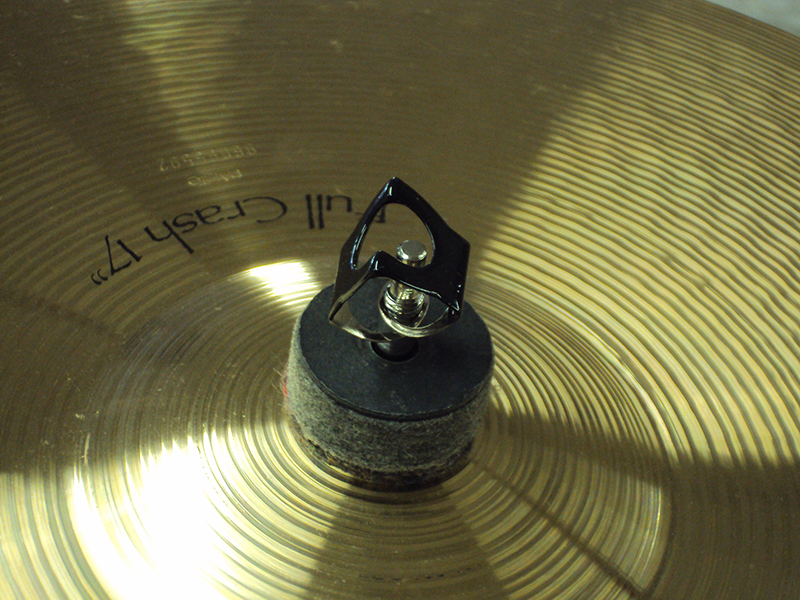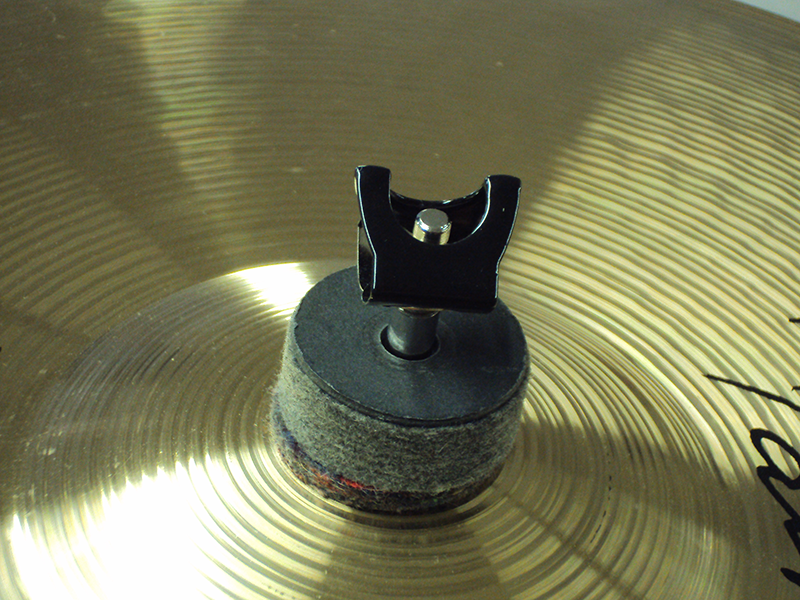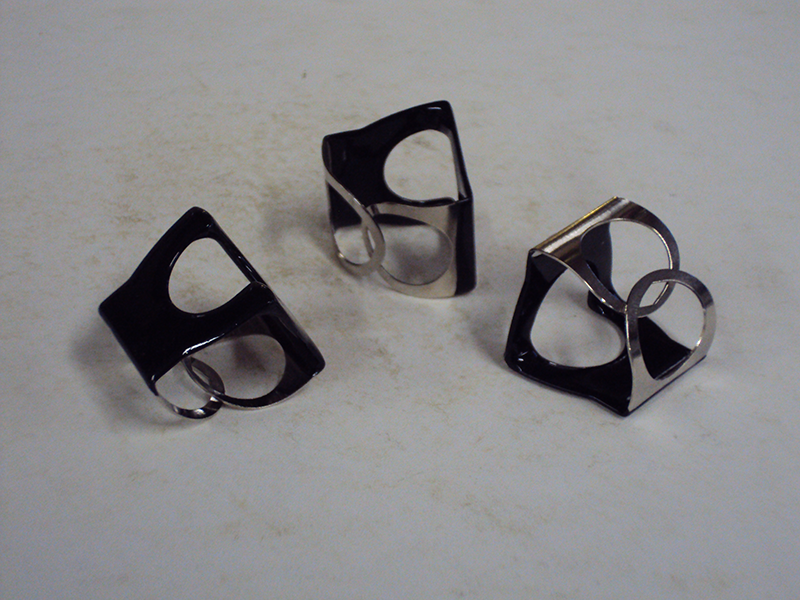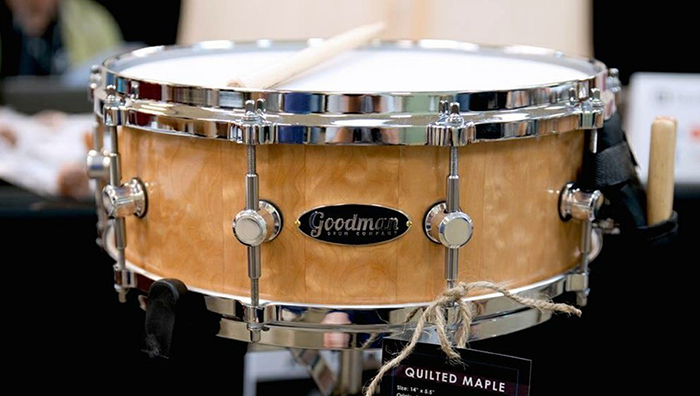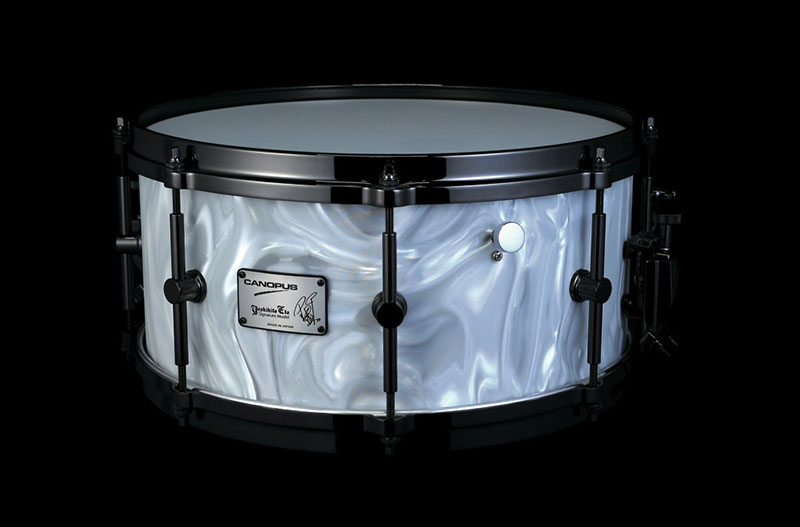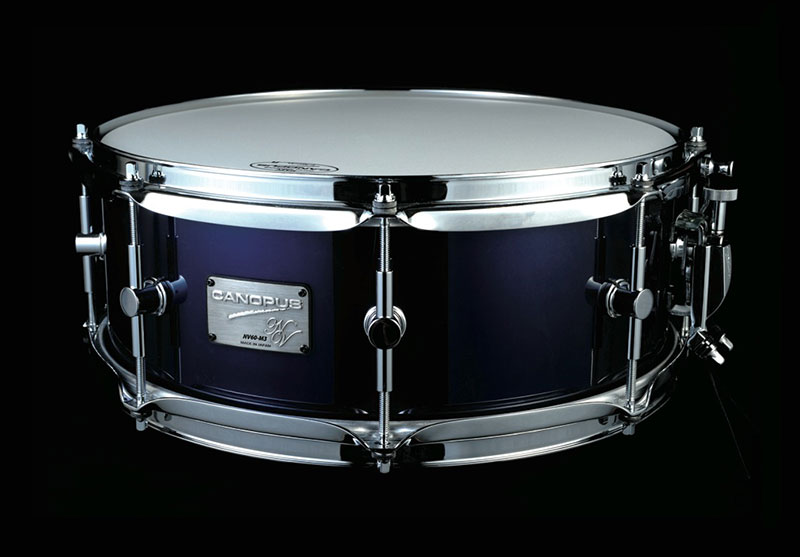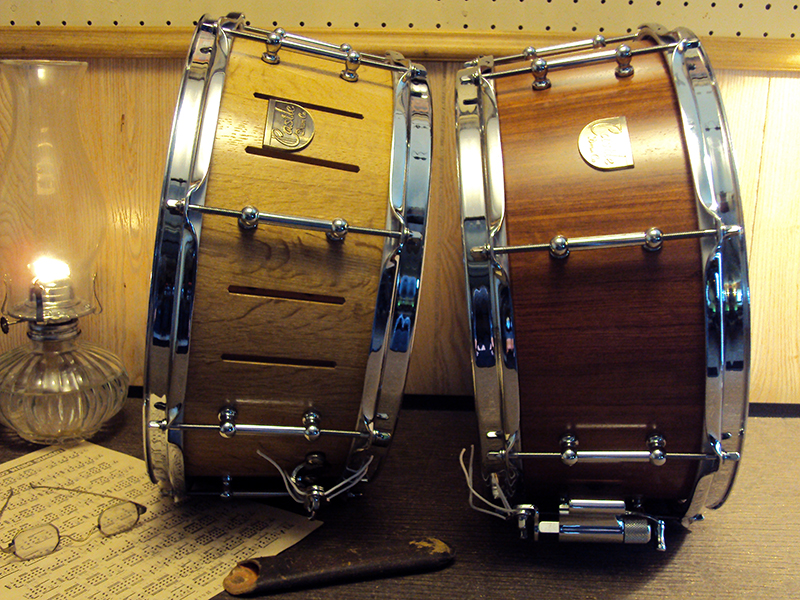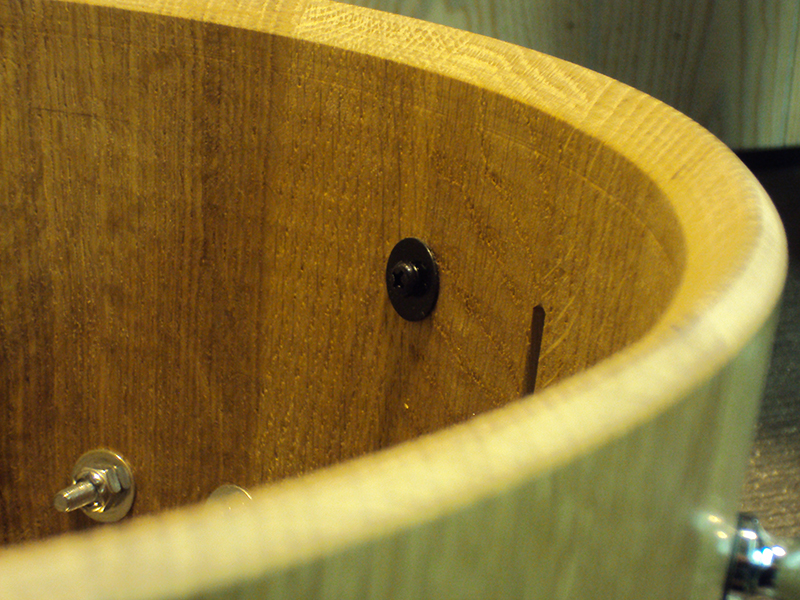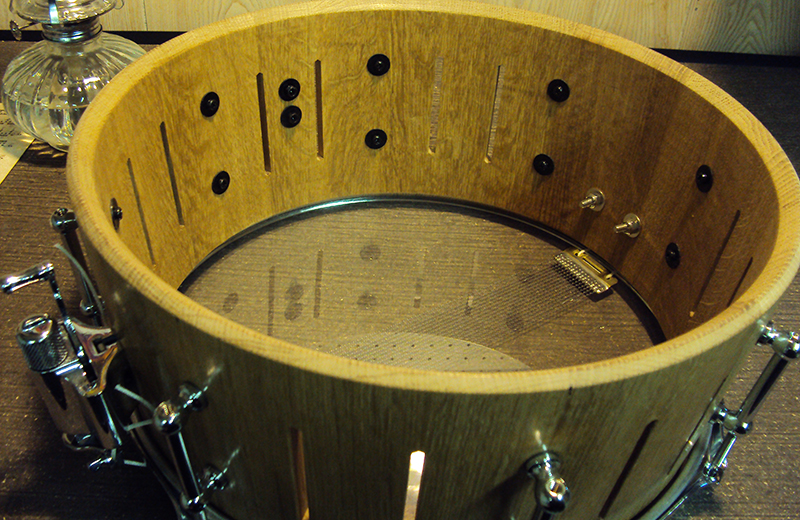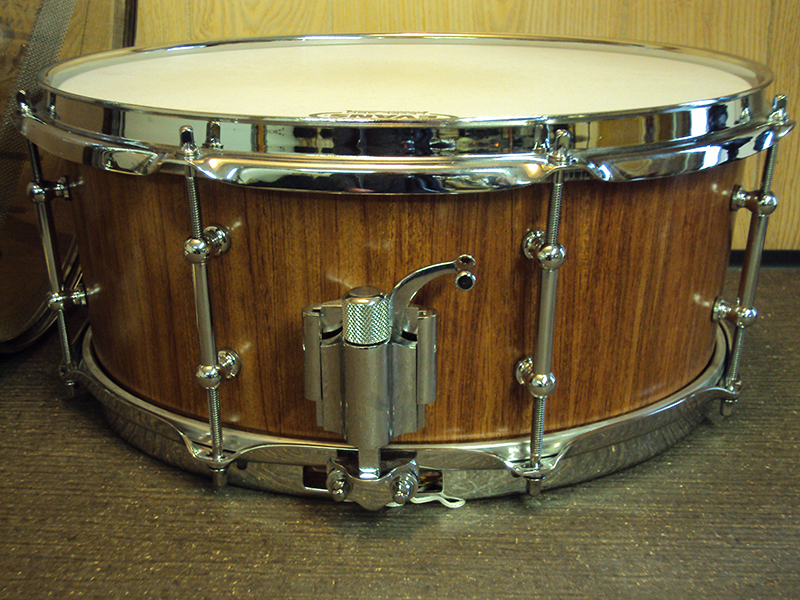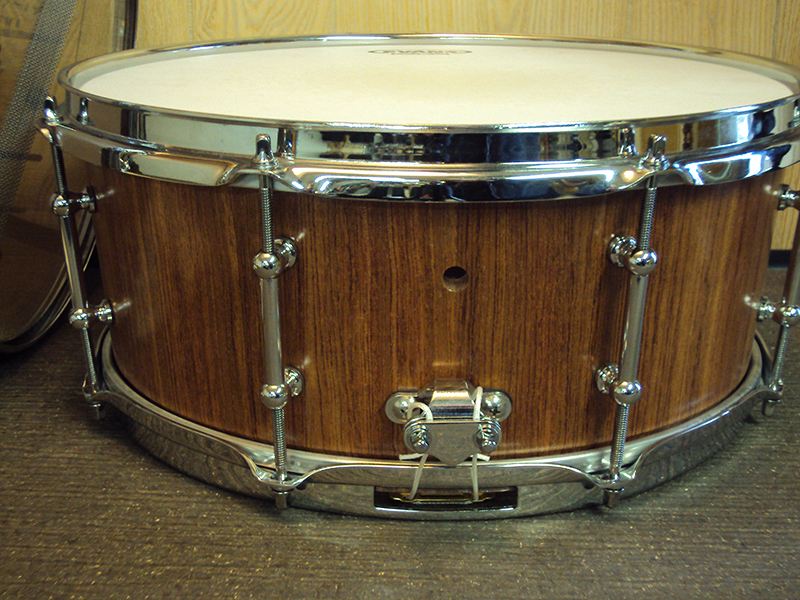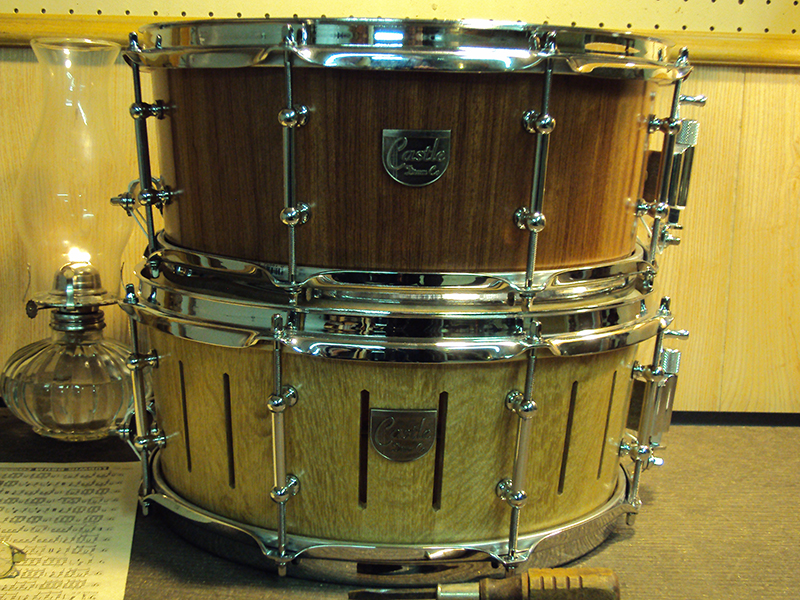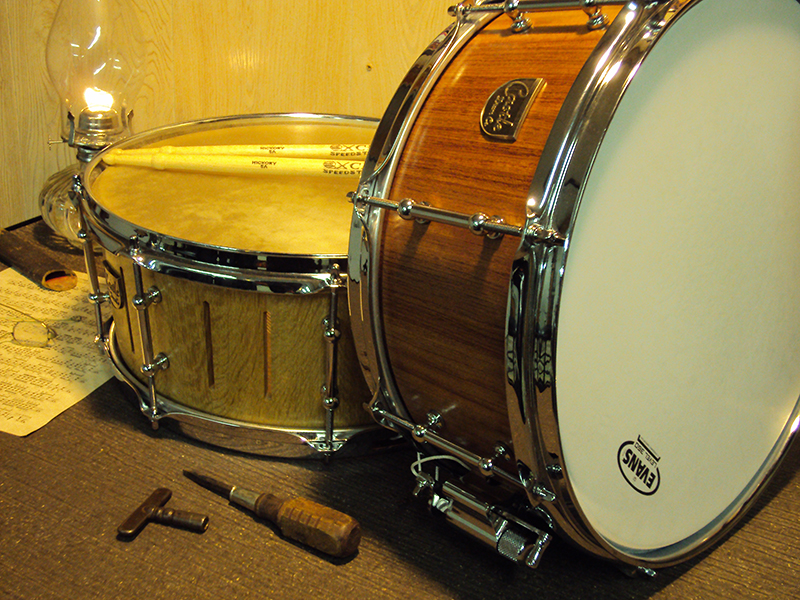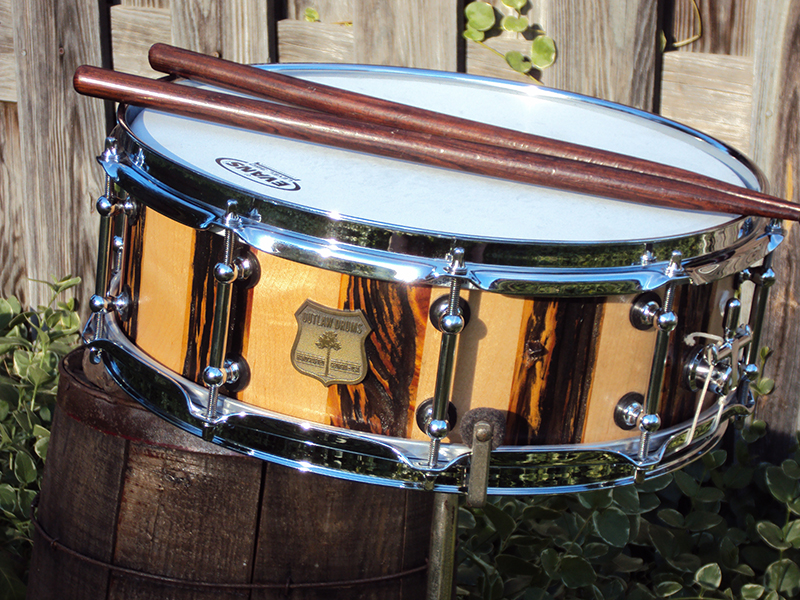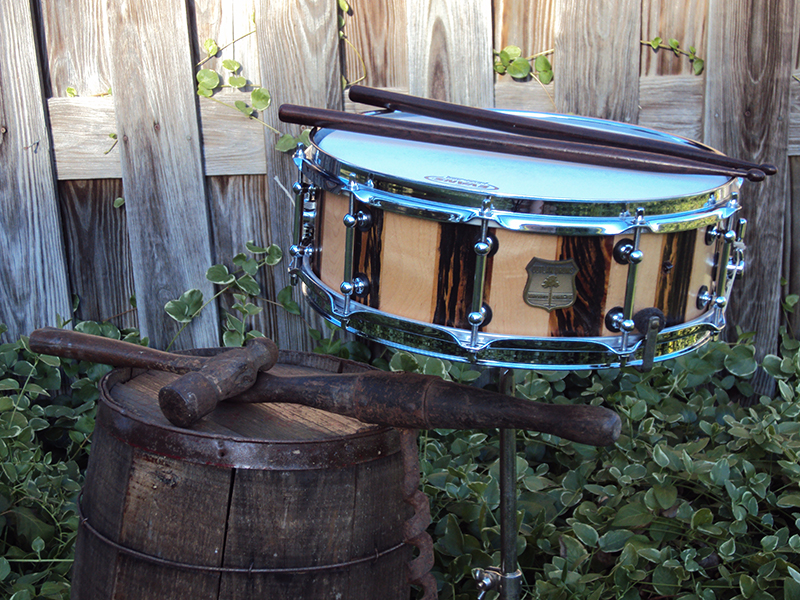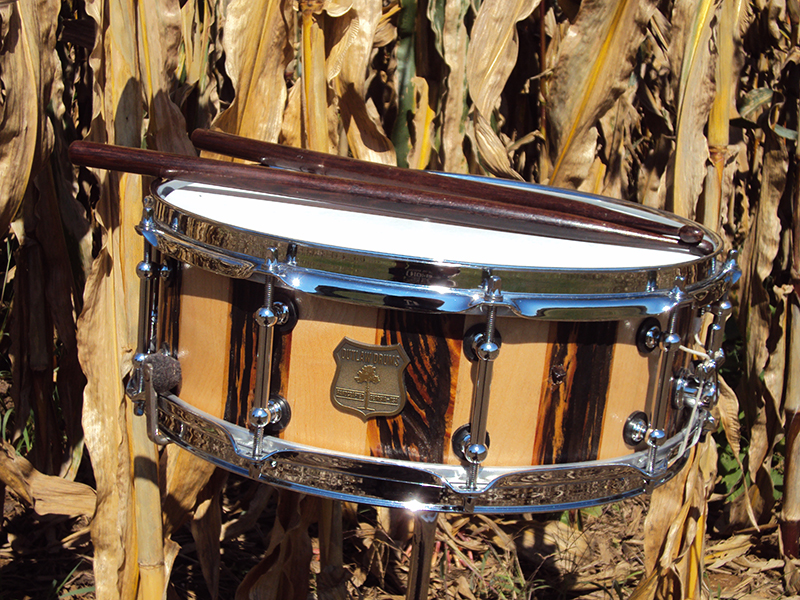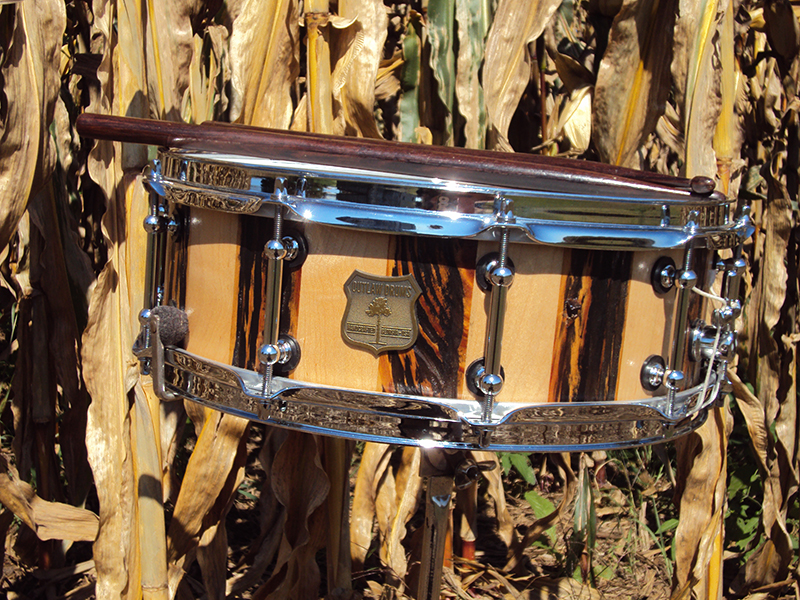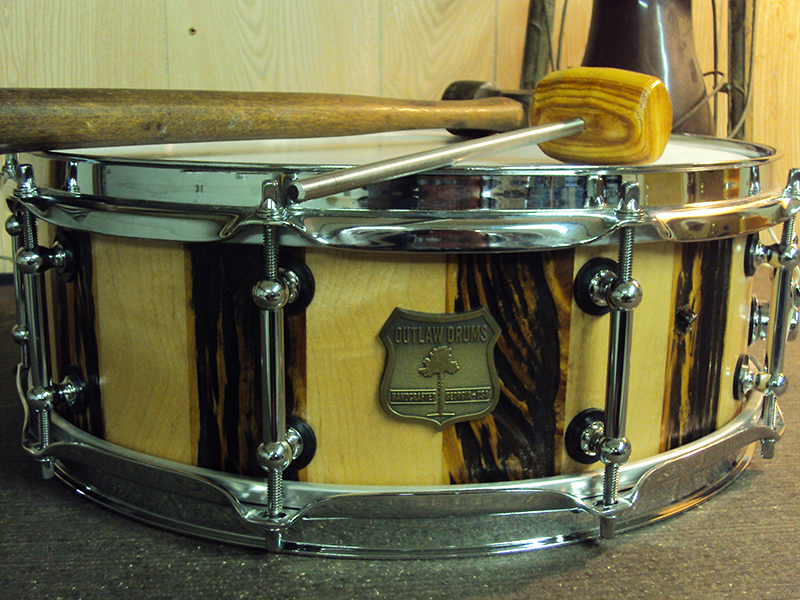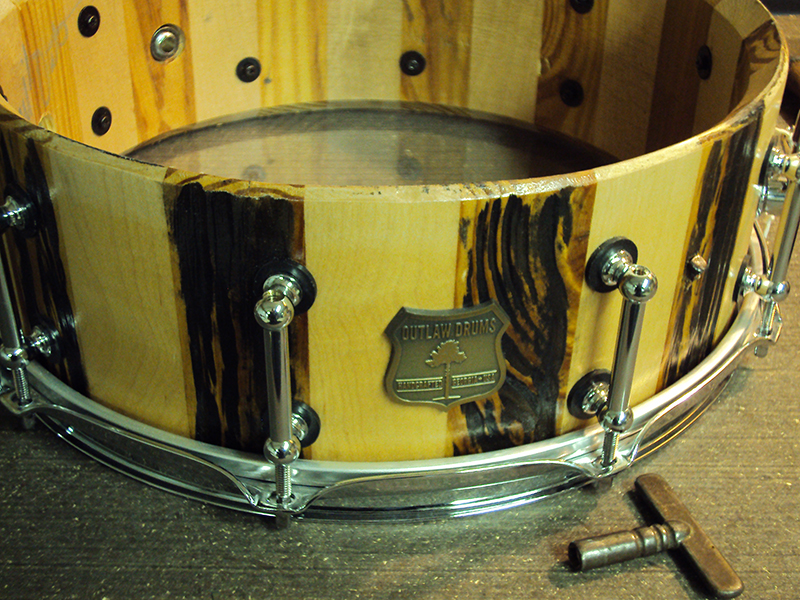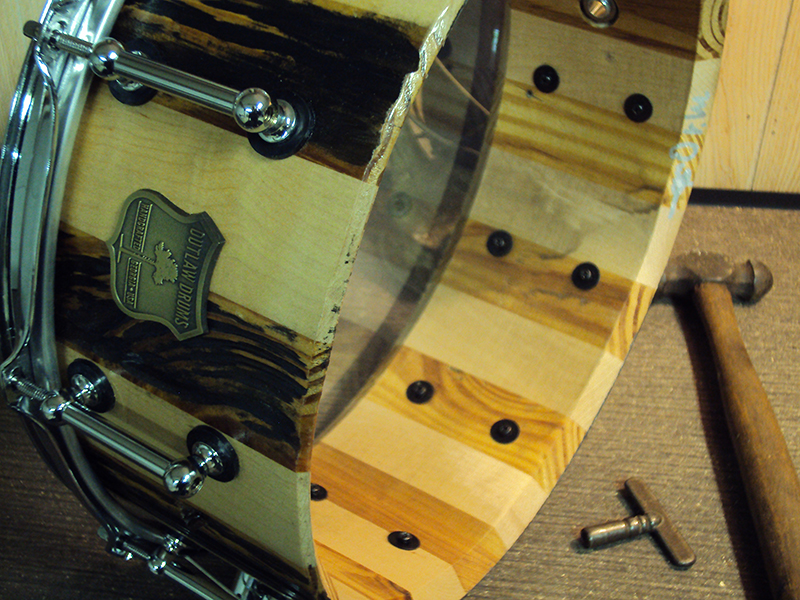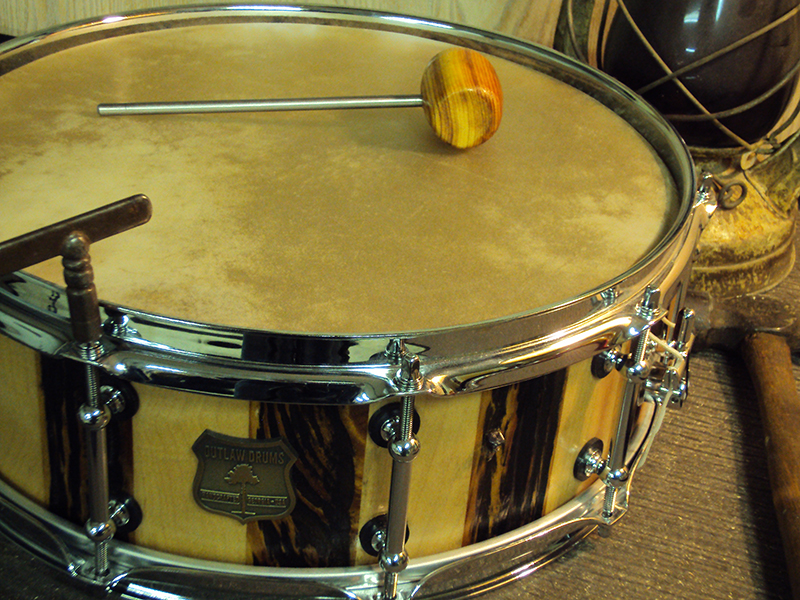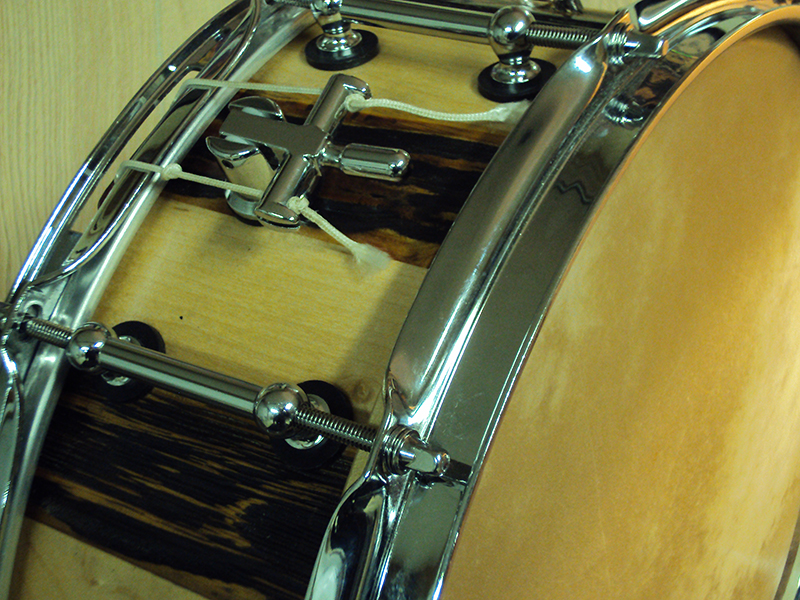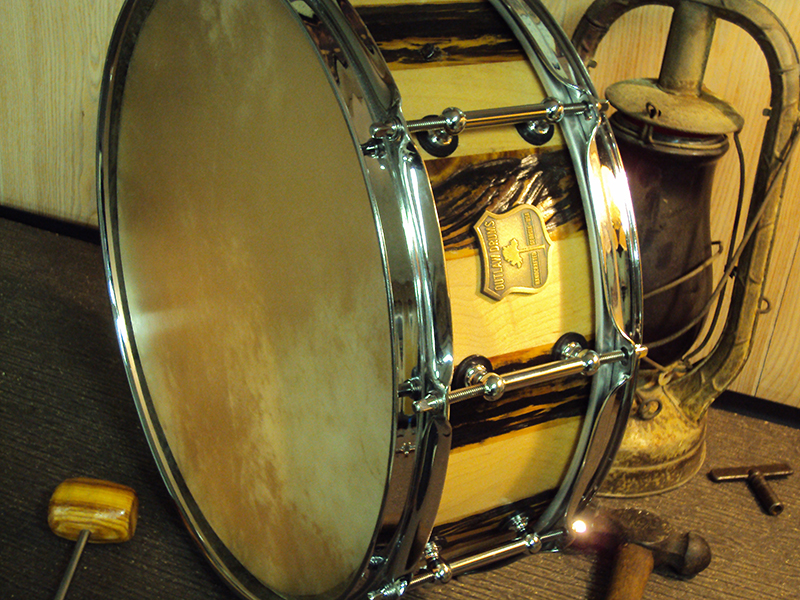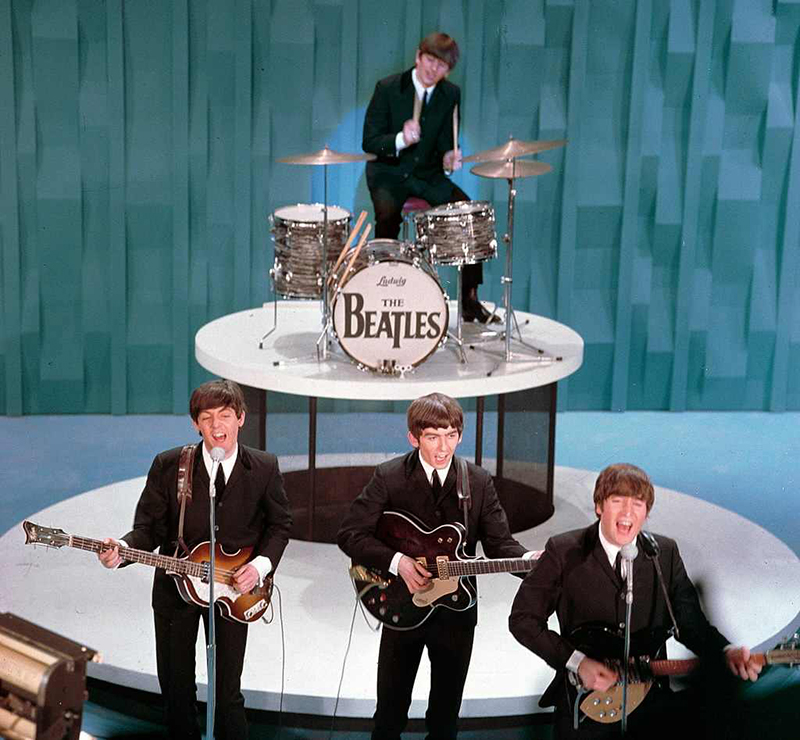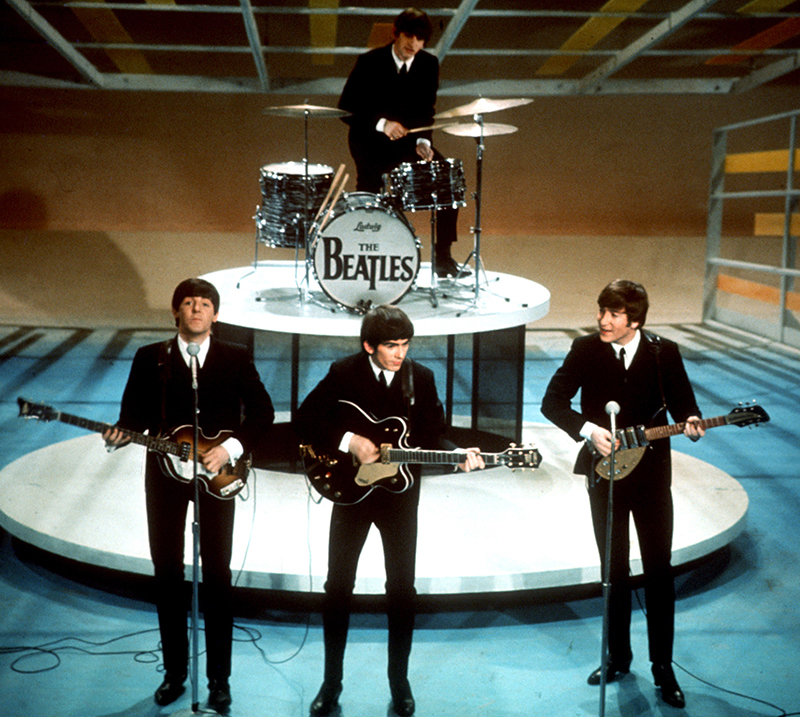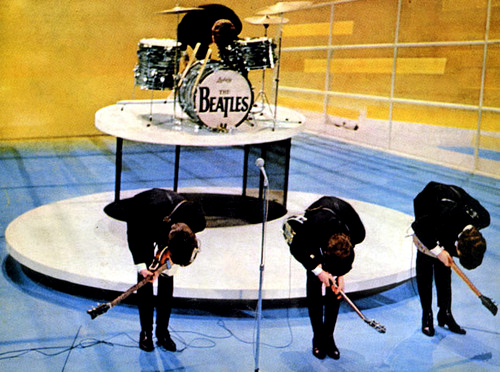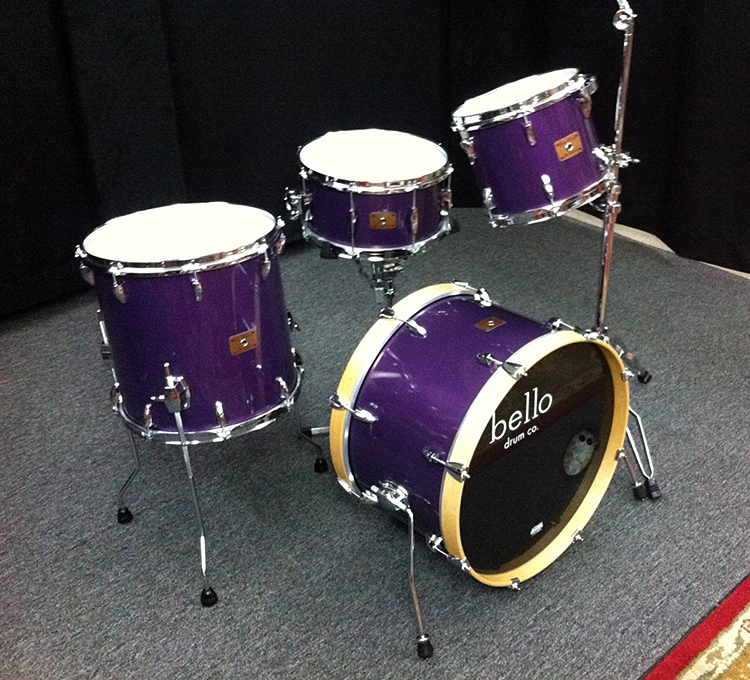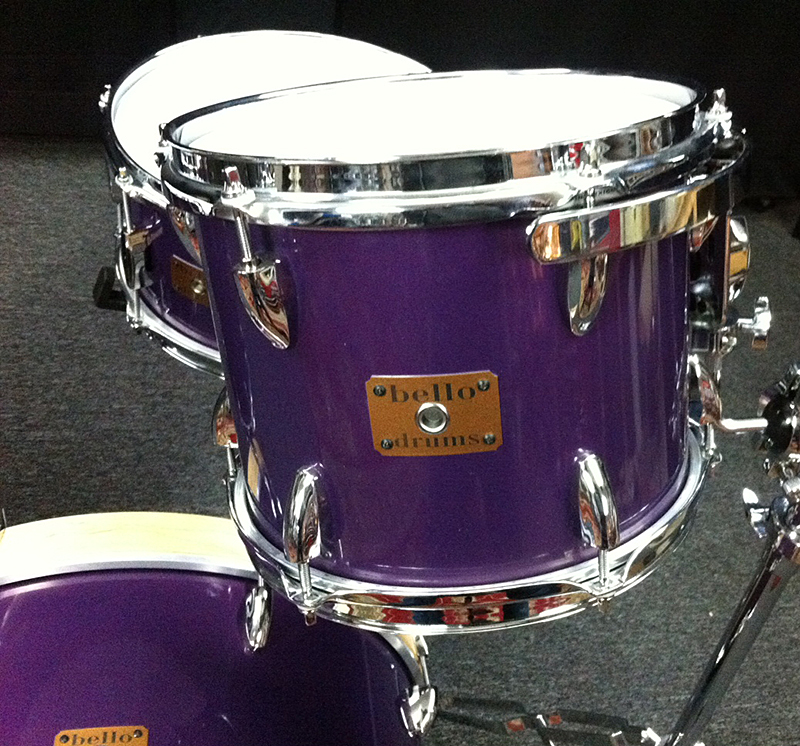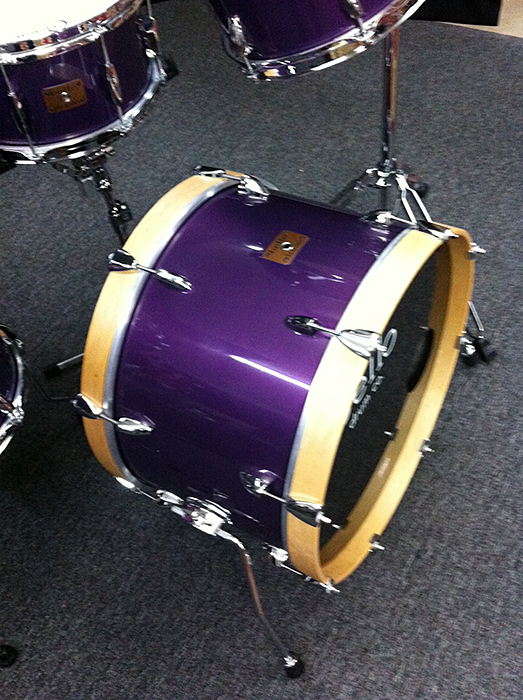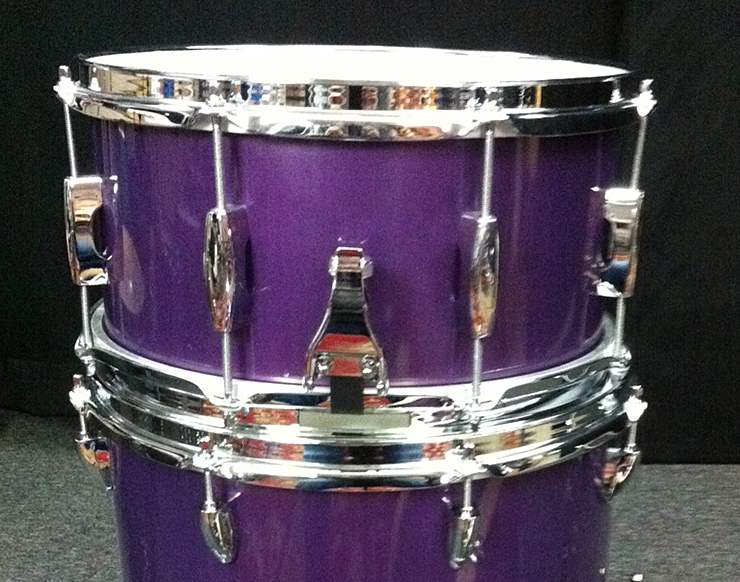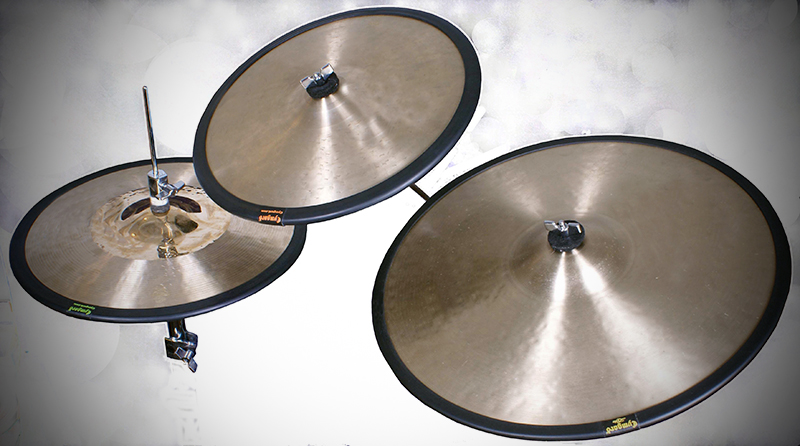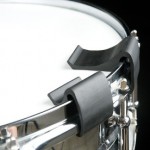I hate to use the obvious comparison, but it does sound very much like the heavy brass Ludwig Black Beauty drums that were made in the seventies, which are sought after. And I think that’s what Canopus was going for since they mentioned it on their website.
Read morePinchClip Review
Every once in a while you stumble across something so simple and so useful, you just stop and ask yourself: why didn’t I think of that? Straight from the fertile mind of William “Bill” Feldman, comes a simple accessory that almost rivals the paperclip, and it’s just for us drummers. PinchClip was designed to replace wing nuts and other conventional “nuts” for cymbal stands, accessories, and hi-hat clutches. In just about any situation that you’re using some sort of screw-nut or have a lip to attach to, you can apply a PinchClip.
Just squeeze the PinchClip together with your fingers and place it on the threaded rod of the cymbal tilter and forget about it. Not only will it cut down on the time spent messing around with a wing nut, it will also allow you to properly adjust the space between the “nut” and the cymbal. This small detail will allow you to decide on the fly, how you want that plate swing, or not to swing. PinchClip grips so tight I literally picked up the stand with the plate attached, by the PinchClip, and took the entire assembly for a walk around my studio! No problem!
The next little trick I tried came directly from Bill. He suggested I attach the PinchClip to the bottom of the hi-hat clutch, replacing the screw nut. One thing I really don’t like is having the bottom nut of the clutch work its way loose in the middle of a tune and fall off. You know the game: the top plate stops moving and you no longer have hat control. This worked really well for me, and when it was time to set up and then tear down, the task was done in a moment. You can also apply it to the top position of the clutch, essentially replacing that nut as well.
Bill Feldman is a working architect who studied product design in college and just thought there was a better way to set up and tear down his drum set and save time in the process. PinchClip works very much like a binder clip and is made of specially treated spring steel and is available in a vinyl coated red or black color. At some point in the future, I would expect additions colors to become available.
I must say, I think this is one of those little gadgets that’s very much worth your consideration. Not only did it work as well as advertised, it looks really cool, too. Anywhere you use a conventional nut, you could probably apply a PinchClip. Just think: no more wasting time and effort searching for those dropped wing nuts concealed in the dark and cluttered mess of a stage following a gig. You might even save enough time tearing down to beat the singer or even a horn player out the door for change!
From Lancaster County PA……Thoughts from the Shop.
Brian Hill
Goodman Quilted Maple Stave Snare
The Goodman Drum Company sent in a very high-end snare drum for review that sounded great on my gig last night (and I’m pretty picky). The instrument’s body is a 14 by 5.5 Quilted Maple stave shell that is 5/8” thick and has a double 45 degree bearing edge. It has wide and deep snare beds similar to the old Slingerland Radio King bed which I personally like because of the responsiveness. The flawless, grade A quilted maple wood has a beautiful hand rubbed clear coat that takes two weeks to apply and has a UV inhibiting agent. The hardware on the drum includes ten polished solid aluminum center lugs with receiving tubes that give it the look of a tube lug drum, die-cast hoops, a Trick throw off, and Pure Sound snare wires. The 3 small unique snare vents in the shell are aligned vertically in one panel of the drum and sit flush with the shell. No cheap hardware on this drum. It appears they using only top shelf parts. The badge is die-cast with a script logo on a glossy oval background trimmed with a silver/chrome-ish border. Very understated tasteful badge.
Sound? This is a full-bodied snare drum sound. At high, medium and low tunings the fundamental note of the shell is very present. It was very easy to tune and the feel of the tension rods turning in the lug threads was very smooth. The resonance and sustain in the head was very pleasing and musical from the edge to about 2/3 the way in to the center at which point the head became progressively drier until it was very controlled at the very nodal point in the center. I like a snare that allows me to hit in the center for a dry, short, snappy sound but with the option of moving away from center to use the natural ring in the head for longer tones. The snare wires respond very well from edge to center and I was able to dial out sympathetic buzz from other drums with the Trick throw off . The snares sounded great at tight, medium and loose settings. I think this can be attributed to the superb bearing edges snare beds as well as the superior Trick throw off and Puresound snare wires. I’ve noticed that some snare drums with die-cast hoops can be very one-dimensional; too much fundamental and not enough overtones or splash, all crack and no tone. Not with this drum. The die-cast hoop did not “choke” the drum. I usually prefer a triple flanged hoop because I find that die-cast hoops don’t give me enough tone and splash. Not so with this drum. It had a lot of what I call nice “gonk” tone in the sound (think Bill Bruford), which I find is usually missing in many drums with die-cast hoops. I also noticed that the difference between a regular loud hit and a rim shot was not that different in volume, but it was different in tone, which was nice. I play a lot of rim shots on backbeats but did not feel the need to with this drum. Most drums have a much seemingly louder report with a rim shot but the wide range of dynamics of the head hits on this drum with regular hits speaks to the superior response of this drum’s design.
Performance; I took this drum on a three-hour gig with an Allman Brothers tribute band. It was a very loud gig in a small club with another drummer right next to me. I had no problem hearing this drum even though there was no monitor and I had a hard time hearing the little 18” bass drum I was using. I didn’t feel the need to hit rim shots to hear the drum. The tuning held up well. No de-tuning of the tension rods.
Cons? Nothing. A+
The Goodman Drum Company is a three-year-old boutique company run by Chris Goodman Jr. and Sr., who also make other wood products. They make their drums out of rare, re-claimed, exotic and high-end tonal woods. The moisture content of the shell is very controlled at 6 to 8 percent until the final clear coating step. The drums are trued on granite and it is obvious that they are very concerned with producing a flawless instrument with much attention to detail. The Goodman's have plans for expansion in the near future. Their first 13” snare will be introduced in a few months. Lugs, hoops and tension rods will be made in-house in 2016 and their first drum kit will debut in 2016. Their goal is to go national with distribution in 2017. While their website is under construction you can reach them on Facebook.
CUSH Pads for Cymbals
This is one of those reviews that is easy to write because the product is so simple that it either works or it doesn't. It either does what the manufacturer says it does or it doesn't. This one works! CUSH pads are an alternative to the felts you use on your cymbal stand. They are made of a proprietary elastomer material, and are designed to allow the cymbals to ring longer and truer without muffling the sound or overtones. They don't collapse or take shape and always return to the original shape.
Read moreCanopus Neo Vintage Snare Drums
Canopus sent three unusual snare drums from their Neo Vintage series for me to review this month: I’m including their specs and descriptions as well.
NV70-M4 (4th of Neo-vintage series)
Shell : 5ply Maple + Poplar 9mm Finish : Superior Maple Lacquer Size : 6.5 x 14 Top Hoop : 12 tension round edge hoop Botom Hoop : 6 tension round edge hoop Snare Wire : Non-plated Canopus vintage wire (CPSL-14DR) Lug : Japanese sword separate lug
MSRP : $1530.95 MAP : $918.57
From Canopus’ literature:
"NEO VINTAGE M4 is based upon the technology and specifications of some outstanding drum designs from the 1970s. Its unique design features 12 tension rods on top and 6 on the bottom. A 5 ply maple and thicker poplar shell construction, and Canopus' precision bearing edge shaping, combine to create a characteristically "mellow and dry" vintage sound. With these specifications - providing a blend of tight attack and a comfortable, loose reverberation, it is a totally unique instrument. Certainly, this conspicuous sound will be highly prized and sought-after by a great many drummers."
Reviewer:
I found this to be the most intriguing of the three drums. I started out with medium tuning. Great sound and throatiness in that range, but the low tone of the poplar and maple shell begged to be tuned down. So I loosened the twelve top tension rods considerably and found the sweet spot on this drum. It makes a great “fat back” drum. The resonance of the drum at the low tuning has just the right amount of “gonk” in it. This would make a great recording drum for those who like to tune low and splashy. I also tried it at a tight tuning, not expecting much from the poplar in the shell but was surprised at how nice and snappy it sounded. Very articulate. I especially like the Slingerland type stick saver hoops. Something about those hoops makes a drum sound “rounder”. It’s the perfect compromise between a softer triple flange hoop and a stiffer die cast hoop. The 12/6 ratio of top to bottom lugs is cool. With the stiffer stick saver hoops, the 8 lugs are not needed on the bottom head, but I would like to hear one of these with 8 lugs on the snare side. The lacquer finish on the maple outer ply is flawless. The Japanese Sword lugs are the coolest thing. Why did Sonor ever let that style go?
SIG-1465YE1 (Yoshihito Eto's Signature Model)
Shell : Maple&Birch Hybrid 8ply Finish : White Satin Wrap (Inner Ply Black Oil Finish) Size : 6.5 x 14 Hoop : Die-Cast BlackNickel Plated Snare Wire : Non-plated Canopus vintage wire (CPSL-14DR) Lug : Solid Brass Tube Lug Black Nickel Plated w/ Inner Muffler w/ Tension Adjustable Butt
MSRP : $1359.36 MAP : $815.62
From Canopus’ literature:
“In order to suit the eclectic playing style of drummer, Yoshihito Eto, his signature snare drum needed the capacity to shine in a wide variety of musical situations - from Jazz to Pop and Hard rock. It needed to be a true "all-rounder", but at the same time it needed to reflect Eto’s playing personality. This was a major challenge - because it is often observed that an "all-rounder" snare drum seems to lose a certain individual character in order to function in all musical situations. Canopus produced many prototypes of this model - in search of the perfect combination of sensitivity, power, "clean" tone, and "complex" sound. We have met the challenge and realised this ideal sound. This drum features a hybrid shell - a perfect blend of maple and birch. The maple provides clear, clean projection and birch adds complexity and character to the sound.
To fully realise the potential of this hybrid sound, we have achieved a perfect balance of several elements - we have utilised Canopus' precise edge shaping, snare tension adjustments at both strainer and butt-end - to control the snare wire more efficiently, and an internal muffler which allows the tone to be controlled and varied at any time - even mid-song! The potential of this snare drum is infinite - all elements of the sound can be directly changed and controlled by the player. This is a remarkable instrument, of which the Canopus company is justly proud.”
Reviewer:
Beautiful drum with great color scheme: white satin flame wrap and black hardware. Very clean sounding. The die cast hoops give it a stout voice, but does not dry the head up completely like I’ve experienced on other snares. The snare response is very nice at tight, medium and loose tensions. The tension knob adjustment on the butt end is a nice feature. I especially liked the internal muffler. I‘m not a fan of muffling but on this drum the muting was effective without choking the head. It would make an all around workhorse drum that would be at home in many music genres.
NV60-M3 (3rd of of Neo-vintage series)
Shell : Phenol Fiber Finish : Deep Ocean Wrap Size : 5.5 x 14 Hoop : Steel 2.3mm Snare Wire : Plated Canopus vintage wire (CPSL-14NP) Lug : Solid Tube Chrome Lug
MSRP : $946.67 MAP : 568.00
From Canopus’ literature:
“With these unique drums Canopus has brought back the drum sound that was immensely popular from the mid 1960's through to their peak in the 1980's. Since that time fiber drums have become increasingly difficult to find. Fiber material has particularly unique sonic qualities when compared to wood or metal shells.
Canopus' process is to layer "craft paper" with phenol resin and apply a heat treatment (known as annealing) to the shell. This allows us to considerably harden the surface layers of the shell to get the best sound as a drum shell and extract the optimal sound. The combination of ideal shell hardness and thickness, combined with the perfect bearing edge, has allowed us to recreate the vintage fiber sound - Neo Vintage M3.”
Reviewer:
Warm, and deep. Not at all what I expected from this unusual type of shell. Very meaty and throaty tone. Easy to tune. Snare response is great. The tube lugs keep tension off the shell and add to the resonance of the drum. I would love to have this drum in my arsenal.
Outlaw Drums Wooden Kick Drum Beaters
This is one of those reviews that is easy to write because the product is so simple that it either works or it doesn't. It either does what the manufacturer says it does or it doesn't. This one works! CUSH pads are an alternative to the felts you use on your cymbal stand. They are made of a proprietary elastomer material, and are designed to allow the cymbals to ring longer and truer without muffling the sound or overtones. They don't collapse or take shape and always return to the original shape.
Read moreCastle Drums
Growing up in the shop of a Master Craftsman and Industrial Arts teacher, my Dad taught me a lot about making and fixing things. I learned about metal, leather, printing, mechanical drawing, and woodworking, among many other things. But the most important thing he taught me was quality. While making my rounds at the Nashville Drum Show, I saw many drums that were made with top-notch quality. But even amongst all the quality instruments that were present, some stood out a little more than others.
As I approached the Castle Drum Company’s booth, I at first thought I needed to get more sleep because the drums seemed a bit skewed. Taking a closer look I realized that my vision was fine and the drums were indeed, a bit skewed. David Cheney, the Master Craftsman behind Castle Drums, had come up with something special and a bit different. David had spent over a quarter of a century in fine woodworking as a maker of cabinets, building case work and furniture. Working with odd shaped and intricate pieces, his ability dictated a higher level of thinking about wood and the possibilities therein.
As many of us find as we become older and more proficient in life, we tend to start to figure out what we like and how we want to spend our time. David decided at one point that combining his love of woodworking and drumming might pacify that angst. After all, drums certainly can be made of wood. The one thing that he knew was that he did not want to be just another guy out there painting and assembling drums: he wanted to set himself apart from the rest of the herd. For that, David would have to dare to be different.
Keeping some of the principles of basic physics in mind, he rationed that if you could channel the sound waves of the batter head down to the snare head in a more efficient manner, you would have a more resonant snare response. Turns out he was right. By funneling the sound waves by way of a slightly conically shaped shell, that energy would become somewhat concentrated onto the snare head. With the application a vertical stave construction shell, the grain of the wood is also in turn aiding in directing the flow of sound waves toward the bottom snare head. This inner vertical grain direction also contributes to providing a little “extra” in bringing out the low-end fundamentals of the shell.
David sent me two drums to review for Not So Modern Drummer magazine: The Keystone and the Watch Tower models. Both drums were very similar but couldn’t be more different in some respects. Each shell had a 7/16” thick stave construction, six inches deep with a fourteen inch batter head. However, the shell tapered down to a thirteen inch diameter for the bottom snare head.
David told me that they did some sound testing with results indicating an average of “20% more bottom head movement, and about three decibels more off the resonant (snare) head than other drums.” These drums are very snappy and produce a great snare response with lots of volume.
The hardware on each drum was chrome plated and included triple flanged hoops, an RCK throw-off and butt, as well as tube lugs. Snares were 16 strand and Evans heads were applied top and bottom. The vent hole was left un-reinforced. Both drums came with very nicely worked 45 degree bearing edges, but, for that “vintage sound,” rounded edges are offered on request.
This Keystone model is made of Bubinga wood, while the Watch Tower drum came in White Oak. Tung oil was applied to the inside of each shell while the outside is nicely lacquered. In playing with different tunings, I thought the Bubinga drum was considerably brighter than the White Oak. The Oak had a much more porous and open grain while the Bubinga was a very tight grained wood; thus resulting in the expected and predictable timbres of each shell. Both drums exhibited a wide tuning range, both high and low. As always, I switched out the plastic heads for pre-mounted calf-skin heads from CT Pro Percussion. The calf skins worked out really nice as they added that warm and earthy sound and feel they’re known for.
I find both drums exceedingly versatile in application. However, the main difference in the two models was that the Watch Tower model has a series of vertical slits in the shell. This plays well with another basic principle of the physics of sound associated with drum design and engineering. Drums are thought to usually project sound mostly from the top and the bottom heads, throwing the sound vertically up and down. They do, however, have an inherent tendency to throw the sound horizontally through the shell. In opening up the lateral sides of the shell via the slits, the Watch Tower drum distributes the sound in all directions. My initial reaction to this is that I think this particular model is exceptionally well suited to the environments of orchestra, concert band, jazz or any “un-miced” small group situations.
The Castle Drum Co. uses a variety of hardware to choose from and includes, but not limited to: RCK, Trick and Dunnett throw-offs, die cast and triple flanged hoops, a variety of lugs, snares and heads. Wood ranges from maple, white and red oak, birch, ash, and mahogany. For something special, try an exotic wood such as zebrawood, purple heart or bubinga. If David can find it, he just might build you your next favorite drum in your choices of dimension and hardware.
I find these drums are in fact fun to play and easy to tune. They tune like a fourteen inch drum but snap like a thirteen. The stick-to-head response is really nice, offering an ease in playing involved passages at lower volumes. Back-beats are exceeding fat and full of rich snare sound. Sensitivity of snare response at the lower volumes is again, very good. As far as the higher volumes: they’re loud!
One of the more surprising and pleasant characteristics of the solid shell was that the effective strike zone was at least double the diameter of most other drums I’ve played. This certainly makes the drum much more forgiving than many if a player tends to play with a wider, wilder strike-zone. The slotted shell (Watch Tower model) did not have quite as wide a strike-zone as the solid shell due to the characteristics inherent to the open design, but was still exceedingly responsive across the head non-the-less.
In examining the Keystone model made of Bubinga wood in particular, I had a very hard time locating the individual wood segments as the joints are tight and the grain is matched as close as possible. After giving these Castle Drums a good go, I would really like to take a look at the furniture David Cheney makes. If the quality is even close, I think anyone who has any of his work must be very pleased. The craftsmanship and quality on these drums is of a very high standard. David’s passion and enthusiasm is very evident and the pride he puts in each drum is extraordinary.
Take a minute and visit the Castle Drum Co. on line. There is a very well made video with David in the shop and more models and options to ponder. If you’re looking for something unique and well made with extreme snare sound and response, not-to-mention a really big, fat back-beat, these drums deserve some real consideration.
From Lancaster County, PA…....Thoughts from the Shop.
Brian Hill
Outlaw Drums: Heart Pine Reborn
Anytime I come across an early American drum, I’m interested. When the drum in question can be somehow identified, I’m really interested. But how often do you come across a drum maker that identifies the origins of his drum making story to a civil war soldier and his house? Now you have my attention. Michael Outlaw attributes the origins of the drums he builds to an old dilapidated building he saw on the verge of being torn down and destroyed back in 2006. Looking for something different to build with, he asked for some of the wood from the house and took a load of it away to his shop.
The wood came from the former home of Charles Edward Wilder, who as a youth in the 1860’s, enlisted in the 17th Georgia (GA) Infantry as a private. A large portion of the 17th GA’s service was as part of Benning’s GA Brigade in Hood’s Division, Longstreet’s Corps, operating in the Army of Northern Virginia. Wilder fought in many of the Civil War’s most notable battles in both the Eastern and Western Theaters. Surviving the War, Wilder received 10 acres near Albany, GA from the State for his service as that was about all that was available to the returning veterans for any means of compensation. The land was rich with virgin long leaf pine trees suitable for building. Charles Wilder built the house from the wood of those trees in the 1880’s; the very same house Michael Outlaw procured wood from to build the first Outlaw Drums well over 100 years later.
Why is the wood so special? Most of it dates back toward the 1600’s. These trees grew at an exceptionally slow rate of growth. They were virgin American trees that typically lived over 300 years and could grow to over 150 feet high. The resin in the wood was thick and the grow rings tight. Harvested from houses, mills, and barns built before 1900, the wood has had plenty of time to age and dry naturally. This results in very special sound quality characteristics that new growth wood just doesn’t seem to have.
Hailing from Sylvester, Georgia, Michael Outlaw, the master wood craftsman behind Outlaw Drums, combines his skills as an accomplished furniture maker with the drummer within him. I’ve found in researching the company that Michael has done a fine job in marketing the brand, so I’ll try not to be too redundant in what he has already made available. His presence on the web is solid and informative. He includes the history, current reviews, process, galleries, sound bites and videos.
I first ran into Outlaw drums at the 2014 Nashville Drum Show. The display was very eye-catching, built to resemble the old shacks the wood for his drums originated from. But it was the drums within the booth that weren't something I could just walk away from. They were beautiful! Something I don’t think I’ve seen before was the textured wood on the outside of the shell. After taking a good look I started tapping. They sounded as good as they looked. By the end of the show, Michael ended up sending a drum and a wooden bass drum beater home with me to review for Not So Modern Drummer Magazine.
The drum I picked was one from the Heart Pine Reborn group; a stave construction combination of new growth maple and old growth heart pine. The shell measures 5”x 14” with 24 half inch thick staves of pine and maple equally alternating. The combination of the two woods made a great sound; lively and solid no matter how I tuned it. It also contained that “thump” I’ve come to love in those old growth, stave constructed drums that makes them sound like much beefier tubs.
The sensitivity and snare response was also incredible. Everything from a hard hitting backbeat to ghost notes came out crystal clear regardless of tuning. Cranking it up brought out very crisp, solid notes. Low-end tuning brought out even fatter sound qualities. Very quiet playing still netted great snare response, again, regardless of the tuning pitch. No matter how hard I hit the drum, I couldn’t get it to choke; performing very well in the big rooms and outside situations. With snares off, the drum has a great sound, full and clean. The lively-ness of the drum without the snares on sounded great with Latin tunes. My personal opinion is that this is a top-notch, all-around “go-to” drum
Since the overall vibe of Outlaw drums tends to pull on the heart-chains of my American history “Jones,” the notion to try a calf skin head naturally came to mind. I generally keep a few mounted skins in my shop that I receive from CT Pro Percussion for just this purpose. The sound of calf skin on this drum was truly exceptional. Very warm and responsive, the drum took on the tone of a much older sounding instrument while remaining quite sensitive and crisp over-all.
This particular model came with chrome plated hardware including triple-flanged hoops, tube lugs, vent grommet, and a George Way “beer tap” throw off by Gibraltar. Top and bottom feature Evans Level 360 heads along with sixteen-strand Puresound snares. The Outlaw Drum badge is solid brass and made to reflect the U.S. Forestry Service badges in honor of the history and repurposing of this native American wood. The bearing edges are a double 45 degree design.
Each Outlaw drum I played had a uniquely individual sound quality. This is in part to the actual lumber used as well as the combinations of wood, dimensions, heads, and hardware selected. Wood choices include, but are not limited to, White Pine, Maple, Oak, Vintage Cypress and Fur, Sapele, Lyptus, Southern Yellow Pine, and of course…..Heart Pine. There is a full and ever-changing selection of wood and hardware finishes also available for your choosing.
Complete stave constructed drum kits are available in a variety of sizes and finishes to match any snare they make. There is also a line of kick drum beaters affectionately known as the “Hammer.” This wooden beater will bring exceptional power and massive thump out of your kick with its incredibly dense wood, each with three angled impact choices.
Michael Outlaw has hit a complete home run as a drum builder, all while managing to bring the history of the wood that has touched countless lives in countless ways back to life in the voice of a drum. From out of the Southland, these drums look good enough to be thought of as fine American furniture. There is even a hand-cut nail still attached in the wood shell from when it was part of a building. Closer inspection of the interior found an old nail hole still present in the old wood. If the history is still with the wood when comes into the shop, there’s good chance it will still be attached when it leaves the Outlaw Drum Shop as a drum. All-in-all….this drum just sounds great!
From Lancaster County, PA…....Thoughts from the shop. Brian Hill
Review: Canopus Yaiba Bop & Yaiba Groove Kits
I’ve known about Canopus’s high quality drums for a long time, having played one of their unique Zelkova wood one piece barrel shaped snare drums in my drum shop in the 2000s, and sold their accessories. I heard my first Canopus drum set at a NAMM show around 2006. The very small bass drum on that kit sounded huge and attracted a lot of attention. I had high expectations of these Yaiba drums before they even came out of the box. The Yaiba line has been around for three or four years and this is their new revised kit – revised for lower price but not lower quality. Both sets list for $1500 which is quite a price drop from the original Yaiba kits. Canopus’s drums and sets have never been cheap because they don’t make any cheap drums. This new Yaiba set is their first set that I think puts their sets within reach of the amateur or working drummer who wants to afford a very high quality drum set at a mid-line price. To achieve this price point on an already existing line, Canopus says that they adopted a different approach to the shell construction, heads and hardware from the original Yaiba kits. They also switched from nitrocellulose lacquer to a standard type of lacquer that reduced the time of the drying process and shortened their overall production time and cost. The new models also come in many color choices - Yaiba gray sparkle lacquer, dark red sparkle lacquer, ebony lacquer, and matte white lacquer. The word Yaiba means “Japanese Sword” by the way.
The Groove Kit sizes are very standard five piece sizes ; 18x 22 bass, 8x10 and 8x 12 toms, 16x16 floor tom, and a 6.5 x 14 snare drum. The shells of the Groove Kit are birch and have a nice punchy attack with a healthy underlying low end. This kit is aimed at the rock, funk, pop, fusion and modern country player who needs a kit that can deliver substantial volume with great tone.
My impressions upon inspecting them:
Snare:
- big fat and rich sound with lots of snap and high end cut
- nice deep snare beds
- canopus vintage snare wires sound great,
- bearing edges great – tuned right up, very rich fat sound, great snare response from very edge to center
- snare throw off is a Canopus proprietary p85 type that works great and has “Canopus” molded into the side of it, a nice touch
- the snare drum sounded great at all snare wire tensions; loose, medium , and did not choke out when tightened heavily
- the double lug design on the snare is very attractive and clever
Toms:
- Very full sounding with lots of distinct cut
- Easy to find the sweet spot when tuning
- RIMS type holders on the rack toms
- Tom mount? The only negative about the whole kit for me - no tom holder on the bass drum or double tom stand. I realize there are a lot of drummers who mount their toms on stands, but a holder on the bass drum for two rack toms is the norm. No mount puts the consumer and dealer in the position of having to have one installed or providing a holder of some kind.
Bass Drum:
- Very deep and powerful, punchy
- Nice adjustable ratchet spurs
- The die cast claws have rubber gaskets that make them line up with the lugs easily and to keep them from gouging the wood hoop, which is finished in the same lacquer finish on the outside
Hardware and Appointments:
- No generic hardware on the drums. All proprietary made specifically for or by Canopus
- Nice sculpted badge. The logo on the bass drum is very classy
- Came stock with Remo UT clear ambassador heads on toms, Nice Power Stroke III heads on the bass. Coated anbassador on the snare
- Beautiful finish. Great looking gun metal glitter type finish called Yaiba Gray. “Very Sparkly” as Rain Man would say
- Canopus’s “Bolt Tight” leather washers included on each tension rod on all drums. Two leather washers with a metal washer in between keeps the tension rod from loosening and also isolates the hoop and bringing out the low end of the shell – they work
Performance:
The Yaiba Groove can be summed up in one concise phrase – this is a very, very, very, very nice sounding and versatile drum set. This is a high level pro kit at a mid-line price. I would recommend this kit to anyone who is looking to step up to a nice five piece work horse kit with a finish that looks expensive.
Yaiba Bop
The Yaiba Bop set sizes are traditional as well – 14 x 18 bass, 8 x 12 and 14 x 14 toms, and a 5.5 x 14 snare. The shells are maple and have the warm and pleasing sound that maple is known for. This kit is aimed at the jazz or small group player, but the bass drum can be tuned quite low and is more full sounding than the average 18” bass drum. It could be substituted for a 20” bass drum easily.
My impressions upon inspecting them:
Snare:
- One word; snappy! Most plywood snares sound boxy to me, but this one had a nice bright attack with lots of body and no midrange boxiness.
- Snare response is exceptional from the edge of the head to the middle. Snare wire tension sounded great at loose, medium and tight settings.
- Tuning it was easy
Toms:
- Warm and big. Nice round notes at high and low tunings.
- Plenty of attack and lots of sustains. Nice blend between the two.
- Single bass drum mount for the rack tom with ball and socket arm. Yay! Thank you very much.
- Rims type suspension mount for the mounted tom.
Bass Drum:
- This is the biggest reason to buy this drum set. Canopus’s 18” bass drums are known for their big, deep sound. I don’t know what they are doing to achieve this, but they are in a class by themselves.
- Fitted with ratchet spurs and with matching paint on the hoops.
Appointments and Features:
- I already mentioned the bass mounted tom holder.
- The red glitter paint finish on this kit is stunning. They call it Dark Red Sparkle. Very classy. Nobody would kick this finish out of bed.
- The workmanship on all the hardware and the chrome plating is top notch. There are no compromises in the construction and machining of this instrument.
- The heads on this set are all Remo Ambassador coated medium weight heads.
Performance:
The Yaiba Bop set has a great sonority. When we play a small drum set tuned open with no muffling, we want the drums to blend pleasantly in a chord. The Yaiba Bop set, if tuned correctly, achieves this. I tried the toms and bass at very high, medium and low tunings. A very pleasing and sustaining blend was present at all tunings. The dynamic range is wide. No choking out at high volume and nice whispering tones w pianissimo strokes. Definitely a beautiful sounding jazz set that can double as a small setting pop or funk set.
My overall impression and rating of the Yaiba line is a solid ten out of ten. From a construction, features, performance, and visual standpoint, Canopus has delivered a superior top shelf professional instrument in two configurations at a price that is attractive.
Harvey Mason Releases New CD – “Chameleon”
I got hip to Harvey Mason in the early seventies when the Herbie Hancock Headhunters album came out with a huge top 40 jazz- funk instrumental hit “Chameleon” (which Harvey co-wrote). Harvey was one of the best of the first wave of jazz funk drummers of that era to play on popular records, along with Mike Clark, David Garibaldi, Jack Dejohnette and others. He has gone on to play on countless recordings with major jazz and pop artists, and released his own well-received solo albums.
The musicians on this CD are a mix of newcomers and great veterans such as Paul Jackson and Bill Summers, the other 2/3 of the Headhunters rhythm section, and Jimmy Haslip of the Yellowjackets.
The song Chameleon is revamped here with some nice new chord changes in places and a different but very, very funky groove. Other well known jazz funk songs include Grover Washington’s “Black Forest”, Bobby Hutcherson’s “Montara”, Quincy Jones’s “If I Ever Lose This Heaven”, and “Places and Spaces” by Donald Byrd.
I don’t go into long descriptions of music in my reviews. I feel that “writing about music is like dancing about architecture” – Frank Zappa. Just let me say that I give this one a thumbs up and I’ve played it many times since I got it a couple of months ago. Harvey doesn’t play it safe on this one. There is some adventurous blowing and the instruments and mix sound great. Harvey’s drums and drumming sound great. Well worth buying the CD or buying the download.
If you aren’t familiar with Harvey Mason’s ridiculously long list of recording credits, go to : http://www.allmusic.com/artist/harvey-mason-sr-mn0000668112/credits
Have a seat and prepare to be impressed. You can hear samples from the new album here: http://mediakits.concordmusicgroup.com/p/chameleon/listen-to-the-album.html
The new CD is on Concord Records was released on April 29, 2014.
Gregory Caputo: Classic Swing Drumming
“ If you want a swinging band, get a swinging drummer.” - Phil Woods
Drummer Gregory Caputo compiles over forty years of playing experiences into his recently released book: ‘Classic Swing Drumming – Methods and Techniques for Development of the Swing Feel’. Caputo brings a vast wealth of knowledge to the subject; having toured with the bands of Count Basie, Cab Calloway, Jimmy Dorsey, Tommy Dorsey, Duke Ellington, Benny Goodman, Lionel Hampton, Harry James, Sammy Kay, Gene Krupa, Nelson Riddle, Artie Shaw, and numerous other jazz legends.
“The intention of the material is to instill a solid time pulse, enhance dexterity, and most importantly, to establish a swinging time feel into your drumming skills.” - Greg Caputo
Greg breaks his book down into easily understood sections focusing on the history of swing music, embellished with recollections and vintage photographs. Caputo’s personal definition of a swinging drummer is: “One who creates a swinging, propulsive beat with a soulful rhythmic feel, contagious to musicians and audiences alike.” Greg further analyzes the foundations of the swing pulse and the anatomy of a swing feel. Every example is fully transcribed with many accompanying exercises. Integrated throughout the book are recollections from musicians describing exactly what they want to hear in a drummer. Other areas of focus include notable swing drummers, the sound of swing drums, accented swing rhythms, and swing feel beat placement.
“I have known Greg Caputo his entire drumming career. He understands the heart and soul of swing.” - Phil Woods
Numerous swing exercises are transcribed throughout Greg’s book, including: hand and foot endurance, various roll and dexterity exercises, and coordinated independence; emphasizing the importance of virtuosity and musicality.
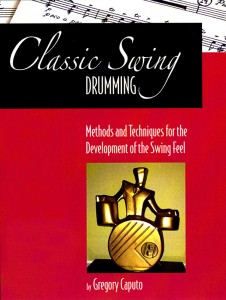
“Greg, You are doing jazz and your students a great favor by focusing on that elusive, but basic element of the jazz tradition. Swinging comes from the soul, an inner source, and an awareness of the rhythms of life around us.” - Dave Brubeck
Caputo’s book includes over one hundred pages of exceptional information focused on swing concepts. Drummers who want to master the various techniques and forms of swing should definitely check out his “Classic Swing Drumming” book and a companion CD entitled: "Classic Swing with a Modern Drive."
Contact Gregory Caputo @ (413) 896-0327 bigbandbeater@aol.com www.gregorycaputo.com Greg plays DW drums and hardware exclusively
MBW Drums Sleeping Beauty 6.5x14 Aluminum Snare Drum
What separates one drum builder’s instrument from another? We used to say it was unique lugs or a unique badge, but there are so many independent drum builders out there now and so many drums on the market it is getting hard to tell them apart. So it always comes down to tone, doesn’t it? How does the drum sound? How does it feel to play it? Is it just another pretty face or does it stand out from the crowd when you hit it? Does it light up the eyes and the ears? Michael Bouvier of MBW drums has a new model that is one of the best sounding snare drums I’ve ever heard, and it’s also a beauty; a “Sleeping Beauty”.
The 6.5 x 14 shell is a thin aluminum straight cylinder with no bearing edge flanges. The bearing edge is a single forty five degree cut to the inside with a slight round over on the outside. The snare beds are deep and wide which cuts down on buzzing.
The finish on the shell is classy and elegant - weathered aluminum with copper vein patina. It’s a completely hand finished effect. No two will be exactly alike. The hardware is all brass; 2.5mm brass single-flange hoops, full length brass tube lugs and a George Way type, hand turned brass beer tap throw off with détente tension settings, all weathered by hand and sealed to protect the finish. The aging and weathering of the finish is so realistic that, at first glance, this drum appears to be a very old vintage drum.
Sound: When I first started tapping and hitting this “Sleeping Beauty” snare drum, I thought I might be over reacting because it was the first drum I had heard that day. It sounded phenomenally great but I wanted to be sure of what I was hearing. So I went around the Drum Room and hit some of my first string and holy grail snares as a point of reference.
My ears were not deceiving me. This drum has some serious, serious tone and it is elegantly beautiful to boot. Several of my pro students came in a little later and had the same reaction and opinion.
I don’t like to use over used words like “crack”, “loud”, etc. to describe drum sounds. The first word that came to mind with this drum was “rich”. The fundamental tone is very evident with a nice blend of shell overtones and just enough head ring to give it a little sustain, even with the Evans Dry head. Combined with its very even snare response, it produces a nice throaty “honk” that I like to hear out of a metal drum. Rim shots have a nice, tight pop or snap to then. The snares responded perfectly from the center to the edge of the head. It came tuned to a medium high note and was very easy to tune down into the “fat” tuning area. Nice big, low sound at that low tuning. The very high tuning was very good – no choking and it gave a nice loud report when I laid into it at triple forte. The drum feels really good to the hands. It is a pleasure to play.
I have a drum track overdub recording session tomorrow in the Drum Room with a name artist and this will be the first snare I will pull out. It would surprise me if they want me to change it out for something different. I’ll report back about that.
The judges’ decision? A solid ten. This “Sleeping Beauty” (love the name) is a keeper. This one is already sold and I am going to miss this one when I have to give it back. I might have to buy one of my own. I really think this falls in the category of a “go to” drum. Each drum will ship with and Evans HD Dry batter, Evans 300 Hazy reso and Puresound Super 30 wires. The snare I reviewed is a 6.5x14. Any size of this model, form 5x14 – 8x14, is sold for $795 shipped anywhere in the continental US.
Additional charges may apply for overseas. Michael says these he has these shells made in any size all the way up to bass drum diameters. Pricing varies on the snares depending on other diameters.
Contact Information:
Michael Bouvier at MBW michael@mbwdrums.com www.mbwdrums.com
Dangerous Illusions: Who Stole Ringo’s Drums?
Q: What do Ringo’s drums – the iconic Ludwig Downbeat made famous on the Ed Sullivan Show, a set of Zildjians – straight from the depths of the family fault, murder, mystery, sex and betrayal have in common?
A: Dangerous Illusions, the new literary crime novel by Joseph J. Gabriele.
Percussionist and novelist Joseph J. Gabriele paints an incredibly rich and vibrant picture in his 268-page murder mystery thriller. While hosting a lavish party at his Park Avenue apartment, Eliot Sexton, a Manhattan writer and percussionist, finds his friend and former U.S. Diplomat murdered and “THE” iconic drum set, worshiped by millions, stolen from his office – and his 70 party guests see nothing.
Mr. Gabriele leads the reader on an unforgettable journey through Manhattan in search of the killer, the thief, the drums, and answers to questions that have unpredictable and volatile consequences. New York is never what it appears to be.
The seemingly effortless blend of drum and percussion details with modern writing is superb, to say the least, and aficionados from the Not So Modern Drummer community will truly appreciate the style in which Mr. Gabriele presents classic instruments, drum shops, and legendary drummers – from Baby Dodds, Chick Webb and Gene Krupa to Joe Morello and Ringo Starr. As a drummer and reader you are instantly transported to the time and place, and the memories that made drumming history – and the many reasons each of us are drumming today. We were equally impressed with the subtle weaving of rhythmic patterns in the writing – and it had us tapping them out as we followed along, slowly becoming one with the characters.
Mr. Gabriele has presented a can’t-put-down thriller, and is well worth the read. The drum addict within us all will appreciate the attention to detail – thanks to Mr. Gabriele’s seven years of researching and writing – conveying knowledge from drum collectors, historians and experts from around the world – including the Ludwig family themselves.
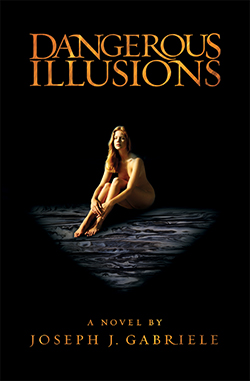
“Not since Dashiell Hammett’s Maltese Falcon has an object of desire caused so much trouble.” – Craigie Zildjian
Dangerous Illusions will be released in hardcover on February 9, 2014 – the 50th anniversary of Ringo and the rest of the Fab Four making their debut in America on the Ed Sullivan Show. It is currently available as an e-book at all major online retailers. For more information, visit: www.dangerousillusions.com.
Bello's Fiberglass Fusion Kit
The Bello Drum Company is the brain child of Bill Haller. In his small workshop in Greenville Pennsylvania, Bill constructs the fiberglass drum shells by hand. Fiberglass drums have been around for five decades and have withstood the test of time, even though they don’t have a large market share. Bello drums are a niche boutique item. All drums are built to order with a good number of color and size options.
The set that Bello sent us to review is called a fusion kit in their price list. The sizes 12 x 20 bass drum. 10 x 9 small tom, 14 x 14 floor tom, and a 13 x 6.5 snare drum in a beautiful purple finish. I would normally call this a “compact kit”, but, upon playing them the small sizes belie the large sound so there is no compromising of tone for the convenient sizes. All the drums had a very nice square badge secured with four small screws. The lugs are pretty standard rounded lugs that give the drum a nice look. Hoops are all 2.3 mm.
The bass drum came with gull wing spurs which fold nicely into the curve of the shell. I’ve always had a soft spot in my heart for shallow bass drums, so I really looked forward to giving this one a test run. The 12” depth makes for a short, quick response. The drum was fitted with an Aquarian clear batter head with built in ring and the front head was a a black Attack Terry Bozzio single ply with port. The wood bass hoops had a nice glossy clear finish and were a nice color contrast with the purple shells. I tried the drum with and without muffling . When muffled, the drum had a nice punchy thump with good low end. Without muffling the same qualities remained, plus a nice sustained low note from the front head. I tried two tunings; a loose medium low and a high jazz-ish tuning. No problem in the tuning range department. Fibreglass drums have always been known for their volume and this bass drum is no exception.
Toms. The toms had a rich, fat, clear, musical sound with a nice sustain. Very warm. The heads were Aquarian coated single ply on top and Attack Terry Bozzio clear single ply on bottom. Both toms had a good long sustain and a wide tuning range. The mounted tom comes with a RIMS holder and bracket for an L arm, but no tom arm or bass drum mounting bracket were included.
The 13” snare drum was very responsive with a nice dry spot in the middle of the head and a nice ringing when played near the hoop. The snare beds were shaped correctly so it has a nice snare response. The throw off is a Taye type lever – a simple throw off. The drum tuned well at low and high tunings. The low tuning with a zero ring sounded especially fat.
All in all, this Bello kit is a very balanced set of drums. This would be a very nice versatile kit that could be used for small jazz and coffeehouse gigs as well as louder pop/rock gigs where a punchy sound is required.
Because of the fiberglass shells and shell hardware that is on the small side, the drums are very light weight. Fibreglass is also very durable and impervious to extreme tempatures and moisture. The 12” long bass drum makes the footprint of the set smaller than your average rock kit, facilitating set up on tight stages.
Bill Haller is making some nice instruments. Give Bill a call or send him an email if you want to find out more. He’s a very hands-on, amiable guy with a great off kilter sense of humor. He can be reached through the Bello website – www.bellodrums.com.
Past Meets Present - Ted MacKenzie
Past Meets Present → Into The Future...Buddy Rich ~ Henry Adler ~ Ted MacKenzie
In 1942, after four years with The Tommy Dorsey Orchestra, Buddy Rich was already considered “The World’s Greatest Drummer.” Soon afterwards, he wanted to develop some music reading skills, so he began to study with renowned drum teacher Henry Adler.
Ironically, he never learned, due to his busy touring schedule. It didn’t make a difference; Buddy Rich was a one of a kind genius with a photographic memory. He could hear a song just once, and memorize it completely. When Buddy sat behind the drums, pure instinct took over. The following quote from drummer Ted MacKenzie sums up Buddy’s relationship with Henry Adler in the 1940’s.
“He never had to practice and no one could teach him. Henry Adler said that Buddy wanted desperately to learn how to read drum notation, but always returned to him empty handed.” - Ted MacKenzie
Adler was keenly aware of the importance in documenting Buddy’s style and technique. This quickly evolved into a collaborative book effort between the two, “Buddy Rich's Modern Interpretation of Snare Drum Rudiments.” Over seventy years have passed since it was first published, and it is still considered the Bible of Drumming. The Rich-Adler method became the standard for all drum books to follow.
While Buddy went on to greater fame, Henry Adler continued teaching the Rich-Adler method in his New York Studio. In 1969, drummer Ted MacKenzie began to study with him. There, Ted also learned additional techniques from jazz drummers, Jim Chapin and Sonny Igoe.
MacKenzie’s name may be unfamiliar to many in the drumming community, yet his reputation precedes him in upstate New York, where he has been teaching for over forty years. He considers the Rich-Adler method to be “the greatest rudimental system on the planet.”
In the mid 1990’s, Ted Mackenzie and Henry Adler met once again. They teamed up to revise the original 1942 edition of “Modern Interpretation of Snare Drum Rudiments.” Adler came out of retirement specifically to work on this essential project. Both agreed it was long overdue. In 2005, the updated version of Buddy’s book was released to critical acclaim. Buddy Rich’s, bible of drumming, is now more relevant for the 21st Century. It became inevitable that Ted would write a sequel expanding on the earlier Rich - Adler concepts. This book is titled “Buddy Rich’s Rudiments Around The Kit” and is available at Amazon, Barnes & Noble and on Ebay.
“Essentially, it’s what you know and how you apply it that counts. I teach drummers what they need to know, so they can apply it with their own understanding. It’s like learning the ABC's. You can't relate if you don't know the rudimental backdrop.” - Ted MacKenzie
I witnessed Ted’s methodologies in the studio, and the ease at which the students were able to embrace his interpretation of the Rich-Adler techniques. One such student is world renowned “Shadows Fall” drummer, Jason Bittner. When Jason is not touring the world, he always finds time to study with Ted. It is a real testament to Ted MacKenzie’s talents. Jason’s feedback on his use of ‘Buddy Rich’s Rudiments Around The Kit’ is:
"A great tool for anyone who really wants to learn the rudiments and how to apply them in a musical setting, rather than just sitting at the pad playing them repetitively just for the sake of practice." - Jason Bittner
Ted MacKenzie’s great skill as both a musician and artist contributes heavily to his teaching methods. Numerous illustrations showing Buddy’s grip technique and hand positions were all drawn by Ted. He also designed and demonstrated the correct rudimental hand and finger positions in photographic form. Ted’s book is the definitive reference on Buddy. The Rich-Adler method allows the rudiments to be adapted to any drum set configuration in an infinite number of ways.
Ted Mackenzie's dedication to both preserving and propagating the legacy of the one and only Buddy Rich is second to none. His 3 books, DVD's, drum clinics, and continuous instruction not only keep Buddy's memory alive, but also sheds light on a method that's relevant to young players of today. If they're serious about the instrument, Ted is the "go-to-guy," both conceptually and creatively. Because of guys like Ted, Buddy's fire continues to burn stronger than ever!" - Bob Girouard, Modern Drummer Magazine
In addition to MacKenzie’s method books, he also developed “The Ultimate Drummer's Workout.” His “Wag the Brush” technique, uses brushes to exercise the wrists, hands, and fingers. This helps to quickly improve speed, strength, and endurance. All of Ted’s teaching materials are meant to work together as a cohesive unit for maximum results.
Buddy Rich protégé jazz drummer, Donny Osborne, had the opportunity to use Ted’s Book, and had this to say:
“The book is clear and well written. For a drummer who has the basic knowledge of the drum kit, this is the book that will absolutely move you to the next level. If you just read what is on the page, and practice, practice, practice, with the right amount of patience you should, in time, be able to accomplish what is in the book. The DVD’s are great tools and help to illustrate the points made in Ted’s book. Seeing the exercises and how they are played helps those starting out, or when you just hit a snag. If you are a fan of Buddy Rich, this is the one to get!” - Donny Osborne
Looking back to 1919, we saw 18 month old Bernard “Buddy” Rich, amaze audiences, known then as, “Traps The Drum Wonder.” Even at this very young age, it was more than obvious he was destined for ultimate greatness. If Adler had not fully documented Buddy’s style and technique, it may have been lost to the ages. For this, we owe Henry Adler a huge debt of gratitude. Ted MacKenzie continues that storied tradition by optimistically moving forward. He is hopeful that every new generation of drummers will embrace the Rich-Adler method. In doing so, we will keep Buddy Rich’s great legacy alive forever.
Cymgard Cymbal Protection
Something new! Cymgards are elastic rubber edge protectors and dampeners for cymbals. They have three basic purposes;
- To dampen the sound of the cymbal for quiet practice,
- Cymbal edge protection, and,
- Cushioning for the cymbals in shipment or transit.
They are available in three styles: Cymgard Standard and Cymgard Lite for single cymbals, and Cymgard HiHats for pairs of hi hat cymbals. The Standard is a heavy weight rubber that can absorb heavy impact. They are designed to fit, cushion, and shield the edges of your cymbals from damage due to impact and falling. They are available in sizes from 12” to 24”. The HiHat model is the same weight and will accommodate a pair of hi hat cymbals from 13” to 16”. The Cymgard Lites are, you guessed it, a lighter weight model with a thinner profile that is good for less dampening than the Standard, as well as for protection in transit or storage. They come in sizes from 6” to 24”.
While the Lites go on easy, there is a little bit of a trick to getting the Standards on the cymbals the very first time, but once you learn the simple pull and snap technique, it takes no time at all. The Cymgards will break in and eventually mold to the cymbal over time which is great since there can be as much as a ¼” difference between manufacturers’ sizes. They are made well out of a quality rubber that will stand some abuse and not deteriorate.
Performance:
I tried both the Standard and the Lite versions on a 20” medium ride cymbal and an 18” medium thin crash cymbal. When playing the cymbals with the thicker and stiffer Standard Cymgard, they made the cymbals completely dead as one would expect, BUT the feel of the stick rebound off of the cymbal was about the same as an undampened one – very natural. Crashing with the shank of the stick on the side of the cymbals gave a dead “gonk” sound with no sustain, very similar to the sound and feel of hitting a rubber electronic cymbal pad. Perfect for playing with padded drums or a practice pad set. The Lites were my favorite for practice because they allowed some sustain when riding or crashing, though not really louder. The Standard HiHats are not designed for practice, just storage and cushioning. I also accidentally found a different use that was not described by the manufacturer. I placed a smaller Cymgard Lite loosely on top of the ride cymbal and thought "hmmm....what does that sound like?" it let the cymbal ring even a little more and allowed me to crash the natural edge too.
Protection:
I tried dropping and throwing a couple of old cracked cymbals on the ground. The Standards kept the cymbal edge from bending and cracking. I also tried a stand mounted cymbal, tipping the stand over until the cymbal fell and hit the ground. Same protection; no damage. This could come in handy in those bars or gigs where you have to leave your kit set up where a cymbal might get bumped into.
Cushioning:
I tried storing both the Standards and the Lites in my hard cymbal case and in my soft cymbal bag. The Standards take up more space but I would probably use them if I were going to fly the cymbals in checked baggage. I liked the Lites better for storing in the cymbal bag because they serve as dividers that keep the cymbals from rubbing against each other and don’t take up as much space as the Standards.
The manufacturer has a good video on YouTube that demonstrates all of the applications. My score for Cymgard is a solid ten. They do what they are designed to do and the multi purposes make it worth the investment. I can see no negatives. It's nice to see an innovative product that is designed well, manufactured well, and helps us drummers do what we need to do.
Prices range from $11.95 for the smallest 6” to $28.95 for the largest 24”. This is a product that could pay for itself in the long run as it can possibly save a cymbal from cracking or bending, necessitating a new cymbal purchase. Cymgards are sold at the www.cymgard.com website.
Snare Kick Riser Stand
I and probably ten thousand other drummers have had the idea of a pedal operated snare drum. Of course Rick Allen of Def Leppard has been playing an electronic snare trigger pedal for years, but I am not aware an acoustic snare drum stand with foot pedal attachment made by any of the major drum hardware manufacturers. Well, it took a guitar player to actually make a commercial model. Jim Darnell is a guitarist and the owner of Side Kick Drums. The Snare Kick Riser Stand is simply a metal stand that holds a snare drum on its side and has a “lip” to attach a foot pedal to.
It works and it is very simple and well made.
The popular Mumford & Sons with their lead singer/acoustic guitarist pumping a bass drum is responsible for the sacrilege of solo acoustic guitarists playing a lone bass drum with their right foot. Now this gizmo will give them something to do with their left foot!- but I think the biggest market for this Snare Kick Riser Stand may be drummers who want to free up their left hand to do other things. I can see this catching on quickly.
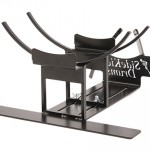 The stand is made of steel that is powder coated black. The two circular cradles for the snare have a firm foam rubber bumper glued to isolate the snare from the metal. The rear cradle is fixed in position while the front cradle is adjustable back and forth to accommodate different depth snare drums, up to 10”. The cradles will accommodate 14” and 13” diameter drums. Even though the drum just “sits” on the cradle while flanges in front and back hold the drum in place, the snare drum is pretty secure without excessive tight clamping. There is a 16” piece of thin flat metal in the rear that serves two purposes; it acts as the “hoop” for the pedal to attach to and acts as a “stabilizer” to keep the drum and stand from tipping over on the site. The spurs in front are adjustable and are attached to a nice front piece that has the company name laser cut into it. This is a well designed piece of gear, made of sturdy but light metal.
The stand is made of steel that is powder coated black. The two circular cradles for the snare have a firm foam rubber bumper glued to isolate the snare from the metal. The rear cradle is fixed in position while the front cradle is adjustable back and forth to accommodate different depth snare drums, up to 10”. The cradles will accommodate 14” and 13” diameter drums. Even though the drum just “sits” on the cradle while flanges in front and back hold the drum in place, the snare drum is pretty secure without excessive tight clamping. There is a 16” piece of thin flat metal in the rear that serves two purposes; it acts as the “hoop” for the pedal to attach to and acts as a “stabilizer” to keep the drum and stand from tipping over on the site. The spurs in front are adjustable and are attached to a nice front piece that has the company name laser cut into it. This is a well designed piece of gear, made of sturdy but light metal.
I tried it with several different size snare drums. It was very stable and it produced the desired effect despite my weak left foot... :-)
The Snare Kick Riser Stand is available from the manufacturer for $109.99 at www.sidekickdrums.com. They also make specialty snare drums and bass drums. Dealers are welcome too.
DrumClip - External Ring Control
This is a nice simple little tone control device that solves a lot of problems. Head treatments over the years, for the most part, have been everything from home made duct tape concoctions to rocket science Rube Goldberg type mechanisms to plastic rings. This product, to me, is the most logical device yet. No moving parts, sleek design, low profile and low maintenance. The idea for DrumClip may have come from the plastic clips on clip–on drum microphones. It can be called a muffler, but overtone controller is a better description.
DrumClip is made of a flexible plastic that snaps securely onto the hoop of a drum. It won’t come off unless you take it off and it stays in place. The broad surface that interacts with the drum head is strategically aligned to put only slight pressure on the head, which is enough to cancel the vibrations in the outer two inches of the head where most of the ringing happens. It comes with two different optional stick on pads; one felt and one rubber pad, that can be applied to the unit to further dampen the head.
What I like about the way DrumClip works is that it isn't attached to the head like plastic do-nut rings, duct tape, wallets, etc.
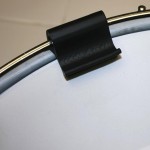 It stays in place and the head vibrates against it (or doesn't vibrate against it depending on how you want to look at it). DrumClip is small enough that it can stay on the drum when in transport in a case or bag, or thrown into a stick bag or cymbal bag. It can be detached on the fly for those times when you don’t want ring control. There are two models; the Regular DrumClip for toms and snares 12” and larger, and the Small DrumClip for toms 12” and smaller as well as larger toms. Both models can be used on bottom heads as well.
It stays in place and the head vibrates against it (or doesn't vibrate against it depending on how you want to look at it). DrumClip is small enough that it can stay on the drum when in transport in a case or bag, or thrown into a stick bag or cymbal bag. It can be detached on the fly for those times when you don’t want ring control. There are two models; the Regular DrumClip for toms and snares 12” and larger, and the Small DrumClip for toms 12” and smaller as well as larger toms. Both models can be used on bottom heads as well.
I played on drums outfitted with a variety of DrumClips at PASIC last month and they work great. I’ve been experimenting with the Regular DrumClip on my snare drums and really like the variation in controlling overtones that I can get with the different pads.
DrumClips can be ordered from the manufacturer’s website www.thedrumclip.com for $6.95 apiece plus sales tax and shipping.
Ancient Tree - "The Architect Model"
Following in the footsteps of so many American drum makers, Ed Mendel honed his master woodworking skills in fields somewhat far remote from drum making. Located in Gainesville, FL, Ed has worked under a master craftsman in cabinet making and is a custom home builder and designer, as well as a General Contractor. Being a life-long drummer, Ed sought out something different in drums. Through experimentation and trial and error, Ed founded a company with a slightly different focus: Ancient Tree Drums.
I first came across Ancient Tree Drums when I was at the Chicago Drum Show a few years ago. They immediately stood out to me from the rest of the crowd. They not only looked like percussive art, but they sounded like percussive art!
The whole presentation exuded a sort of historic…..older-than-dirt….artsy…..and just down-right cool kind of vibe. I ended up coming back a couple of more times, tapping and examining the different models presented before pulling the trigger on a model Ed refers to as “The Architect:” a vertical stave constructed, river recovered, cypress heartwood drum with rock maple hoops and very artsy, dark/rust powder-coated lugs. I just loved the sound I was hearing: It sounded like the snare drum I’ve been hearing in my head for years, and it didn’t look like any other drum around. It immediately became one of my “go-to” drums.
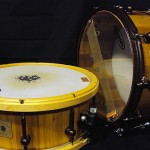 Since then, I’ve had Ed make me a similar drum, another Architect model, with 2.3mm, triple-flanged matching metal counter hoops. The drums are almost identical in construction and design, but, have some very different sonic qualities due to the difference in counter hoops and being from different river recovered logs. (Each Ancient Tree drum has its own unique characteristics.)
Since then, I’ve had Ed make me a similar drum, another Architect model, with 2.3mm, triple-flanged matching metal counter hoops. The drums are almost identical in construction and design, but, have some very different sonic qualities due to the difference in counter hoops and being from different river recovered logs. (Each Ancient Tree drum has its own unique characteristics.)
Both shells are a 6” x 14”, 20 piece stave construction with vertically running grain, which helps to bring out the lower fundamental tones of the shell, and are about ½” thick.
These particular shells have a very solid, low-end punch that I don’t very often hear in a snare of this size. Along with extreme sensitivity and crispness, there’s a lot of power here.
The cypress heartwood has an estimated age of around 1500 years and has spent roughly 150 years at the bottom of a river in Florida. Being a heartwood, it contains a large enough percentage of resign to prevent it from absorbing water, preserving it on the river bed in a relatively “dry” state. The grain of this wood is so tight (as well are the joints holding the staves together) and clear, it rivals maple. This river recovered cypress heartwood is undoubtedly one of the rarest woods around.
Both drums are equipped with Evans heads; PureSound twenty-strand snare wires, Trick three-step snare throw-off, and powder-coated, custom-milled, aeronautical aluminum single post lugs. The lugs and the 2.3 triple-flanged metal counter hoops have a nice dark, three dimensional look and feel that adds to the overall warmth of this small piece of art.
In playing Ancient Tree drums for the last few years, I’ve come to know them pretty well. The shell has the projection of maple, but with a serious warmth and “Earthy-ness” that can only come from this type of wood.
From a response and sensitivity standpoint, I think this may be one of the most sensitive drums I’ve played in years. Every note is clear and articulate at any volume. The main difference I find between the two models centers on the counter hoops. As one might expect, the metal hoops bring out a brighter timbre and overall crack with a certain openness that gives this drum a bit more volume and life than the wooden hoops allow. The wooden hoops seem to give a more controlled sound.
 The difference in the logs that make up the shells also weighs in on the over-all timbre. The model with the metal hoops utilizes some lighter colored wood, which I suppose adds to a slightly brighter sound quality as opposed to the mostly darker colored wood which makes up the rock maple counter hoop drum. Granted, these are all small nuances that make up the characteristics of any drum, but definitely ones you want to take into consideration when picking your next best drum!
The difference in the logs that make up the shells also weighs in on the over-all timbre. The model with the metal hoops utilizes some lighter colored wood, which I suppose adds to a slightly brighter sound quality as opposed to the mostly darker colored wood which makes up the rock maple counter hoop drum. Granted, these are all small nuances that make up the characteristics of any drum, but definitely ones you want to take into consideration when picking your next best drum!
Ancient Tree Drums also come in a variety of other great woods, materials, sizes and combinations. Ed also currently offers other rare and ancient, river recovered heartwoods in Longleaf & Curly Pine varieties, in addition to Black Southern Cherry, and Black Walnut. All wood selections are subject to availability. But as Ed discovers different woods, different models will always be offered. In addition to the rock maple hoops, Ancient Tree also makes some custom hoops with wood combinations such as segmented rock maple/cherry as well as other domestic and exotic materials, along with wood in-lays for that extra touch. The hardware combinations also seem to be varied: to see what Ed and Ancient Tree Drums are currently offering, visit them at the web-site to see what’s new.
So, the sound isn’t necessarily “different”…..it’s just a great sound, which is exactly what Ed set out to do! It sounds like a great snare drum with its own distinct characteristics. If you’re looking for that one drum that combines sonic and visual superiority as well as the craftsmanship and rarity of valuable art, I would have to recommend a serious look at these Ancient Trees and this master drum builder.
From Lancaster County PA, Thoughts from the shop………. Brian Hill
NOMO Finish Protectors
This is just another great example of the famous Plato adage, “Necessity is the Mother of Invention!” Steve Ives saw some of the same “drum needs” that many of us have become all too well aware of, and he actually did something about it. That something became a line of products that are now known as NOMO. Some of these “little fixes” became drum finish protectors, designed to keep your drums from scratching or otherwise damaging each other from contact or rubbing; others, are just intended to be helpful in getting the job done in a neat, stealthy manner. Each NOMO is designed to be used “as is” or custom augmented for each drum or purpose.
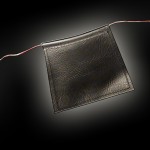 The flagship product in the line is the NOMO protector that started it all. Steve saw that the rim of his snare drum was coming in contact with the finish of the underside of his rack tom and scratching it. He took a piece of durable material, double-sided it, stitched a loop across the top and ran a piece of leather cord through it and tied it off on each side to the drums tension rods. The Finish Protector now hangs out of sight between the two drums, keeping them from making contact with each other.
The flagship product in the line is the NOMO protector that started it all. Steve saw that the rim of his snare drum was coming in contact with the finish of the underside of his rack tom and scratching it. He took a piece of durable material, double-sided it, stitched a loop across the top and ran a piece of leather cord through it and tied it off on each side to the drums tension rods. The Finish Protector now hangs out of sight between the two drums, keeping them from making contact with each other.
Steve also has larger Finish Protectors that protects the bass drum from toms mounted on snare stands. Many of us have found out the hard way that this is also a good way to scratch the finish of your vintage or custom kick drum. Simply place your NOMO on the kick drum in the area of the “danger-zone,” tie it off and stop worrying about it.
With NOMO, the only limitation is YOUR imagination.
The NOMO Kick Hoop Protector guards against the tight grip of bass drum pedal clamps. Many (if not all) kick pedals seem to use hard clamps that squeeze down on both sides of the counter hoop…….marring the finish of even the most resilient drum hoop. This NOMO is made of a single sided piece of the same durable material as all NOMOs, and ties the same way around the drums tension rods, folding around the outside rim of the hoop and coming between both sides of the hoop and the pedal clamp. If the pedal ever slides on the hoop (as some guys kick harder and some finishes could have a “slippy-er” finish than others), some sort of “tacky”material can be glued on the inside of the NOMO material to get a tighter bite on the hoop. Again, fully customizable!
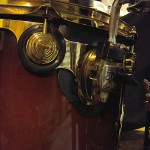 In experimenting with the NOMOs , I found a great new use to combat an unforeseen problem with one of the toms on my kit. It seems that the 16” suspended tom has a “RIMS-like” suspension bracket that apparently has slightly fatigued over the years and was now making contact with the drums lacquer finish as well as making noise. I took one of the NOMO Kick Hoop Protectors (as it is single ply and thin) and custom cut it with a pair of scissors and fit it between the drum and the suspension bracket, again tying off the leather lace with the tension rods. Mission accomplished! This incredibly easy and effective fix is so stealthy that it’s hard to notice, just like all the NOMO products.
In experimenting with the NOMOs , I found a great new use to combat an unforeseen problem with one of the toms on my kit. It seems that the 16” suspended tom has a “RIMS-like” suspension bracket that apparently has slightly fatigued over the years and was now making contact with the drums lacquer finish as well as making noise. I took one of the NOMO Kick Hoop Protectors (as it is single ply and thin) and custom cut it with a pair of scissors and fit it between the drum and the suspension bracket, again tying off the leather lace with the tension rods. Mission accomplished! This incredibly easy and effective fix is so stealthy that it’s hard to notice, just like all the NOMO products.
I usually only use a few pair of sticks, mallets and brushes when I play.....never one to like the idea of taking 20 pairs of sticks to a gig. The other issue I have is I don’t always use a kit that has a free-standing floor-tom to attach an average size or larger stick bag to. The larger, hanging/suspended toms I use much of the time won’t support that type of weight. Steve Ives seems to have come up with the perfect solution for this with the NOMO Stick Caddy. Each one holds two pair of whatever sticks or mallets you are using. It attaches the same way as the other NOMOs by simply tying the leather lace around the adjacent tension rods. They can be hung on the low-end toms (or any other drum for that matter) and even work well laying across the top of the kick drum for a quick grab at a stick.
One evening I thought I would get a little creative with the Stick Caddies. I decided to see about anchoring them to the lower end of the drum shells, thus providing two points of contact with the drum. To accomplish this, I merely took a pair of scissors and poked a small hole on each side of the center stitching about a quarter of an inch inside, and parallel to the bottom tension rods. The next step was to thread a piece of the leather lace through the holes and tie it off to the tension rods. I then repeated the process again for the next tom, adjusting for depth. What I like best about these stick holders is that they stay on the drum when it gets packed away in the case; just like all NOMOs, it folds up with the drum.
The final NOMO I “played” was the NOMO Set List Holder. Made of a heave-duty, clear material, it ties anywhere you want it. Fold your set list in half and insert into your NOMO, now your set list is protected and exactly where you what it: only an arm’s length away.
All NOMOs are available in black or clear material. I have NOMOs all over my kit and they are hardly visible as they are designed to do the job without detracting from the drums. They are easy to adapt to your particular configuration or custom need. With NOMO, the only limitation is YOUR imagination. Steve also welcomes your requests for custom orders and ideas. In short, I really have to recommend these things, you should probably have at least a half dozen for yourself……they’re cheap, they’re simple, and they really work!
From Lancaster County PA, Thoughts from the shop………. Brian Hill




